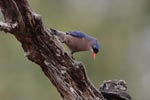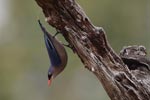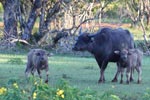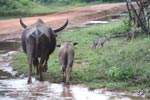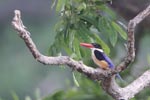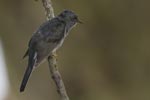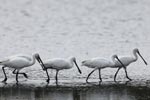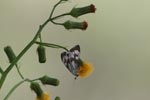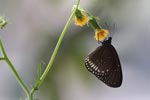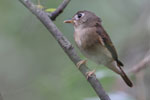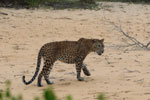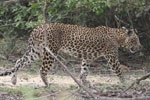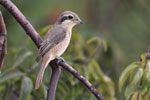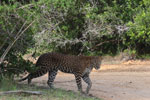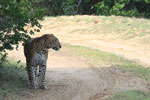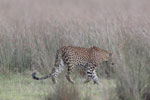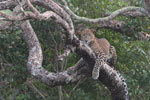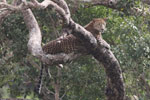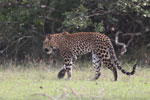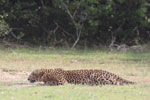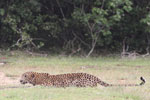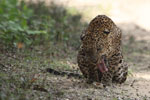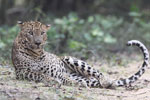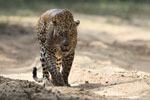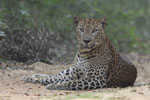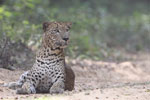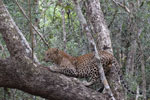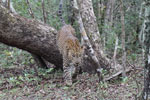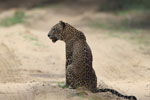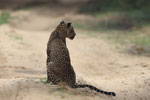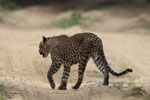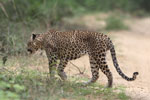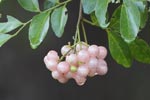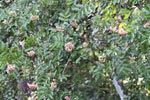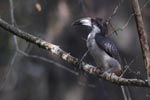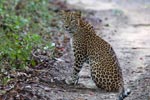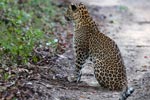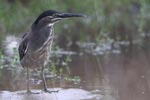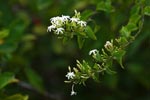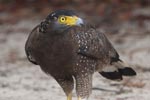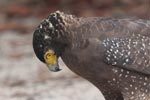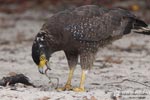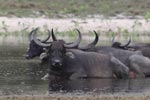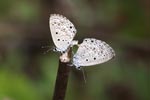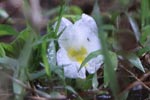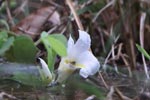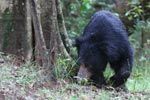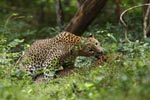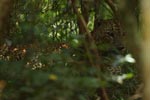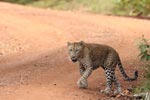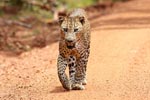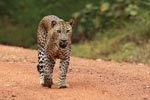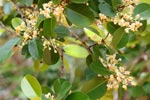
NOTES ON FIELD TRIPS TO WILPATTU NATIONAL PARK
- Wilpattu National Park 29th December 2022
- Asteraceae ceylanica Pupula (S)
- Dopatrium nudicaule Small Horsefly’s Eye (E) Heen Bim Savan (S)
- Gloriosa superba Flame Lily (E) Glory Lily (E) Niyangala (S)
- Hibiscus eriocarpus Maple-leaved Mallow (E) Kapukinissa (S) Wal Wada (S)
6.54am entered the park.
8.40am Velvet-fronted Nuthatch at Palukola Wala. The Nuthatch was examining a tree hole on a dead tree trunk and flew on to a branch closer to me upon being disturbed by a Magpie Robin.
8.56am there was a herd of 7 Indian Water Buffalo including two newborn calves a short distance beyond Palukola Wala. As there were leopard sightings around this location yesterday and the day before I decided to observe the herd for some time to find out whether they would detect scent of the cats. Usually, a herd with calves are extra vigilant of leopards as they often prey on newborn buffalo calves. The females did not even tolerate two Golden Jacal that approached them on the road in their usual slow galloping style. They snorted and charged and the two canines making them dash into the forest.
10.36am a Black-capped Kingfisher at Kumbuk Wila pitiya. The main purpose of my visit for a day was to get some images of this rare migrant species. I was pleased that I was able to spot the bird, but it was across the water body and was not visible without binoculars. As it was too far for any photography I decided to wait. After approximately 5 hours around 2.30pm I was thrilled to observe the bird flying across Kumbuk Wila and settle on the lower branch of a Kumbuk tree. I was thrilled to have got a few good images of this rare and beautiful visitor. Prior to this sighting I had only observed this species in December 2013 at Kumbuk Wila and during the same month in 2017 at Nelum Wila.
10.40am while waiting for the Black-capped Kingfisher observed a Grey – bellied Cuckoo.
10.53am a small flock of Eurasian Spoonbill feeding at Kumbuk Wila.
12.04pm a species of wildflower referred to by a common name in Sinhala as “Hulan Thala” Gynura lycopersicifoliawas in bloom. Photographed a White Marbled Moth Nyctemera coletaand a few Common Crow butterflies feeding on the same. Four subspecies of this moth has been recognized in the world. The sub species in Sri Lanka is referred to as G.l. nigrovenosa, Moor (1879).
2.20pm a Stork-billed Kingfisher caught a “Thilapia fish”, dashed it several times before swallowing.
5.50pm left the park.
Mammals and Reptiles observed during the day.
Mammals - Indian Buffalo 9, Sambhur, Spotted Deer 73, Wild Boar 18, Barking Deer 4, Golden Jackal 2, Ruddy Mongoose 2, Black-naped Hare 2, Toque Monkey, Grey Langer, Giant Squirrel, Indian Palm Squirrel.
Reptiles – Mugger Crocodile 12, Flapshell Turtle 1, Black Turtle 4, Star Tortoise 1, Land Monitor, Common Garden Lizard, Low-land Kangaroo Lizard, Devaka’s Fan-throat Lizard.
Birds, Butterflies & Flora observed during the field trip
Birds – Black-capped Kingfisher, Lesser Adjutant, Painted Storks, Velvet-fronted Nuthatch, White-necked Stork, Brown-breasted Flycatcher, Indian Pitta.
Butterflies - Blue Mormon, Blue Wanderer
Wild Orchids – Vanda spathulataWildflowers –
- Wilpattu National Park 9th to 11th December 2022
- Asteraceae ceylanica Pupula (S),
- Caesalpinia bonducella Gray Nicker (E) Bonduc Nut (E) Kumburu (S)
- Crotalaria laburnifolia Bird Flower (E) Yak-beriya (S)
- Dopatrium nudicaule Small Horsefly’s Eye (E) Heen Bim Savan (S)
- Gloriosa superba Flame Lily (E) Glory Lily (E) Niyangala (S)
- Hibiscus eriocarpus Maple-leaved Mallow (E) Kapukinissa (S) Wal Wada (S)
- Sarcostemma brunonianum Caustic Bush (E) Muwakeeriya (S)
- Solanum sp. Wild Nightshade (E), Wal Thibbatu (S)
8.20am entered the park.
8.30am one leopard ran across the road about 50 meters ahead of the vehicle at Ranawara pitiya. I immediately switched off the engine and waited for almost 20 minutes, but the leopard did not move back to the road.
8.55am a fine specimen of a male Brown Fish Owl was perched on an exposed branch between Percybendi wewa and Thammanna Wala. These owls have large yellow eyes and mature males have an orange ting to their eyes.
11.24am Caustic Vine Sarcostemma viminale Sub sp. brunonianum (Apocynaceae) in bloom at Kokkare Villu. This is referred to as Muwakeeriya in Sinhala. This bush with fleshy dark green stems often takes the structure of a leafless vine. It is indigenous to the country and is also found in Australia, India, and Malaysia. It is often found on other small plants and shrubs and the leaves are reduced to small scale like formations, which are usually not visible. This is a common species at Wilpattu and I have seen it in bloom during the months of January and December at Kumbuk Wila, Kokkare Villu and Panikkar Villu.
12.06pm 2 large Mugger Crocodiles and 21 Spotted Deer at Eriyakkulampooval. These large reptiles will lurk below the surface of water and ambush Spotted Deer when they approach the water’s edge to drink. Thus, deer approach water with much caution fearing these ambush attacks. However, once they are on land the crocodile will make no attempt to hunt as they lack the element of surprise. The deer appear to understand the absence of danger and will continue to feed on grass within a few feet of the basking reptiles.
12.21pm two Spotted Deer stags “locked horns” at Mahapatessa.
4.20pm one bull Elephant at Maha Wewa. He was holding a young Margosa tree that had been freshly uprooted in his trunk and was waving it around. Despite being about 60 meters from the elephant, I could clearly smell that he was in musth, a condition where adult male elephants become excessively aggressive and seek females in eustress to mate. These bulls are quite aggressive and will often charge vehicles without any provocation. During this period secretions flow from their temporal glands and there is dribbling of urine constantly. The combination of compounds in these secretions gives out a unique smell.
5.00pm left the park.
5.10pm counted 111 Spotted Deer and 6 Wild Boar at Hunuwilagama Tank.Mammals and Reptiles observed during the day.
Mammals – Elephant 2, Leopard 1, Indian Buffalo 2, Sambhur 4, Spotted Deer 494, Wild Boar 24, Barking Deer 1, Golden Jackal 3, Ruddy Mongoose 4, Toque Monkey, Grey Langer, Giant Squirrel, Indian Palm Squirrel.
Reptiles – Mugger Crocodile 4, Flapshell Turtle 1, Black Turtle, Star Tortoise 2, Land Monitor, Common Garden Lizard, Low-land Kangaroo Lizard, Devaka’s Fan-throat Lizard, Green Garden Lizard.
10th December 2022
7.07am entered the park
8.11am a Brown-capped Babbler between Thammanna Wala and Maha Wewa. Two birds were on the road engaged in what appeared to be a territorial battle and flew off in opposite directions into the forest upon my arrival. These birds are highly territorial, and a pair does not tolerate birds of the same species in their patch of the forest. I parked at the spot where they were seen and whistled mimicking their call. Within a few minutes they made threatening calls and one bird moved out to examine the “intruder” permitting me to get an image. These ground dwelling babblers spend most of their time foraging among the leaf litter on the forest floor. Birds in the dry zone are paler than those found in the wet zone.
10.47am Vanda spathulate, an indigenous wild orchid and the beautiful Glory Lily Gloriosa superba was in bloom side by side at Kombansanchaipooval.
11.03am a Brown-breasted Flycatcher between Panikkar Villu and Nelum Wila.
This is a common migrant species that can be seen in suitable habitat during the migrant season from the lowland forests up to about 2000 meters in the hills except in the extreme north. It is also referred to as the Layard’s flycatcher. It breeds in north-eastern India, central and Southern China, northern Burma and Thailand. The entire population is known to winter in southern India and Sri Lanka.
It resembles the Asian Brown Flycatcher but can be distinguished by its brown breast and pink legs.
I have always seen this species in tall forests where there is plenty of shade. In such places it can be seen perched on branches or twigs few feet from the ground. During the migrant season they are found at locations close to Colombo such as such as Meethirigala, Bodinagala and Labugama Kalatuwawa. It has a habit of making short flights and returning to the same perch or to a nearby perch repeatedly. I have never seen this species in the Mannar Island or in the Jaffna Peninsula.
This is not a bird, which is easy to see at Wilpattu due to its small size and retiring behaviour and is a difficult bird to photograph in the park.
12.41pm an impressive Sambhur antler at Kuruttupandi Villu.
Five subspecies of the Sambar are recognized in the world. The nominate subspecies, which is found in Sri Lanka, Rusa unicolor unicolor, is also found in India, Nepal, Bhutan and Bangladesh.
The Sambar is found throughout the country from the highest mountains to the coast. Horton Plains National Park is popular for sightings of this species and is the only park in the country where it is found in herds of up to 20-30 animals. In most other forests in the dry zone as well as in the wet zone I have seen them in singles or small groups of 3 to 4 animals.
In Wilpattu the Sambar is often seen in the early mornings and evenings between the park entrance and Walas Wala. During the dry season they can often be seen emerging from the forest to drink at most water bodies during dawn and dusk. In Wilpattu unlike the Spotted Deer the Sambar will not venture far from forest cover to feed out in the open fields during the day as they do in Horton Plains. Most of my sightings in the park have been of single animals or a hind with its fawn.
On 14th of July 2012, I observed a very interesting encounter between a young leopard and a male Sambar at Viranda Wala. Around 07.31am I was parked at this water hole observing a sub adult male leopard (Borupan Wila Male 1 (BWMC 1)) feeding on what was left of a Sambar carcass, partly concealed from view. As I watched the leopard, a well grown male Sambar antler walked out of the forest and started to drink about 50 feet from the leopard. The sub adult leopard stopped feeding and started to stalk through the jungle but stopped about 20 yards from the Sambar. The antler stopped drinking and raised its head, looked at the young leopard but continued to drink unconcerned. The young leopard turned back and walked in the opposite direction for about 30 feet prior to climbing a tree. After drinking its fill, the Sambar left the water hole and disappeared into the forest.
11.21 one leopard at Nelum Wila. N 08.40109, E 079.97971
I was told by Amila, a safari jeep driver, that he followed a leopard that walked from Nelum Wila in the direction of Nelum Wila sand patch, but the cat had moved into the forest a short while prior to my arrival. I parked close to the sand patch expecting the leopard to make an appearance. A vehicle parked a short distance away flashed its head lights and indicated that the leopard was moving through the forest. Within a few minutes an excited Indian Palm Squirrel started its alarm call and the leopard arrived at the edge of the road. Having turned and looked in my direction, permitting me to get a clear image of its face, the leopard slowly walked crossed the road between the two vehicles that was parked about 50 meters apart. He continued his walk across the sand patch and disappeared into the forest. Having checked its spot pattern I noted that this is Nelum Wila Male 4 (NWMC 4).
12.56pm a first winter Brown Shrike at Kudapatessa.
Adult males of this species have a greyish-brown head and does not have scaling on breast and flanks. The female usually has a brown head and fine scaling on the breast and flanks. Young birds, referred to as “first winter birds” resemble the female but has more pronounced scaling on the breast and flanks as in the case with this individual.
3.30pm one leopard at Borupan Wila. N 08.42573, E 080.02257
It was a young male leopard and was seated in one of the small “islands of bushes” found at this locality. After about 10 minutes he moved out cautiously and moved quickly in to another such “island”. There after he walked into the tall grass (Borupan) and moved out of sight. Having checked its spot pattern I was pleased to note that this is the Boralu Wala Male 1 (BRWMC 1), that used to be seen between Ibba Wala and Boralu Wala.
5.30pm left the park.
Mammals and Reptiles observed during the day.
Mammals – Elephant 1, Leopard 2, Sloth Bear 2, Indian Buffalo 10, Sambhur 2, Spotted Deer 222, Wild Boar 57, Barking Deer 4, Golden Jackal 1, Ruddy Mongoose 3, Black-naped Hare 1, Toque Monkey, Grey Langer, Giant Squirrel, Indian Palm Squirrel.
Reptiles – Mugger Crocodile 7, Flapshell Turtle 5, Black Turtle 3, Star Tortoise 1, Land Monitor, Common Garden Lizard, Low-land Kangaroo Lizard, Devaka’s Fan-throat Lizard, Green Garden Lizard.11th December 2022
4.20am I woke up to receive a call from my caretaker Sisira. A large bull Elephant was feeding on the “Mana” grass close to the bungalow. He walked through my property to enter the park. Some bull elephants regularly move out of the park at dusk and return at dawn. They visit home gardens looking for anything edible and feed on the crops of farmers who are not watching over their paddy and “chena” (vegetable) cultivations. These villagers have been engaged in agriculture for generations very much before the erection of the electrified fence around the park. This fence appears to have limited success in preventing elephant movement.
Most families in Hunuwilagama own a plot of paddy and Chena. It is a common practice for the men to spend the night in the “watch huts” overlooking their agricultural plots. Once the produce is harvested, they seldom visit these plots permitting the elephants to feed on the left-over vegetation. Despite the elephants and other wildlife most farmers earn a good income to support their families. Except for one unfortunate death that occurred where an old lady with a hearing deficiency accidently moved into the path of an elephant, the villagers confirm that there had never been any deaths caused by elephants in Hunuwilagama as long as can they can remember.
7.14am entered the park.
9.00am one leopard on a tree at Borupan Pitiya. N 08.42405, E 080.02591
As there was a leopard at Borupan Wila the day before I decided to turn right at Borupan junction and drive towards Borupan Wila. Upon my arrival heard Spotted Deer alarm calls from Borupan Pitiya and drove down to check. Soon I spotted a leopard lying on the branch of a Madang tree overlooking the open glade. It was Boralu Wala Male 1 (BRWMC 1), the same leopard photographed at Borupan Wila the day before evening. Around 10.43am with the sun light becoming stronger the young male climbed down the tree and walked towards Viranda Wala. He then started to stalk some deer feeding on the plains but soon gave it up and moved into the forest towards Viranda Wala around 11.27am. I was quite surprised that no other vehicles arrived at Borupan pitiya throughout this sighting, despite it being a Sunday. This young male is two years and 3 months now.
11.45am an adult male leopard on the Kumbuk Wila upper road. N 08.41842, E 080.00190
It was Nelum Wila Male 5 (NWMC 5), the big male referred to as “Neluma or Nelum Wila big male” by the jeep drivers and guides. I was quite pleased as this is one of the biggest male leopards in the park. He was seated by the side of the road close to Madangaha Wala and vomited before walking towards Kumbuk Wila. I have, on several occasions, observed leopards vomitting by continuous movements of pushing their stomachs upwards and their bodies forwards until it ends up with the cat throwing up. Unlike with humans where, vomiting is associated with sickness, it is a regular activity for leopards and other species of cats. It’s a mechanism by which they dispose of material they have difficulty in digesting, or which gives them discomfort. Cats accumulate large amounts of fur in their stomachs due to licking themselves clean and from their prey which often remain undigested. Thus, they regularly eat grass that has emetic qualities and engage in vomiting to get rid of such material to cleanse their stomachs.
As usual the “Nelum Wila big Male” was quite relaxed and walked with intermittent rests and a short spell of sleeping. Upon reaching a large old Madan tree with a trunk horizontal to the ground he climbed on to the trunk and engaged in scraping the bark with his paws. He was so close to the vehicle I had to use the 100mm macro lens to capture him in the act of scraping. Other than spraying urine and depositing scat, scratching the surface of trees, and leaving scrape marks is a method by which leopards to leave their scent and sharpen/clean their claws. While lying on the road and licking his paws he was alerted by a small herd of Spotted Deer and looked in their direction but continued to walk on the road. On each occasion he decides to lie down I would bring my vehicle to a hault and reverse when he resumes his walk, keeping an adequate distance. Around 1.06pm with the arrival of another vehicle I decided to leave the leopard and drive towards Kumbuk Wila.
1.09pm another leopard on Kumbuk Wila upper road. N 08.41885, E 080.00924
It was a male and was seated on the road but walked off the road into the forest towards Kumbuk Wila pitiya upon the arrival of another safari vehicle. Later upon checking its spot pattern I noted that it was Nelum Wila Male 4 (NWMC 4) that I photographed at Nelum Wila sand patch yesterday.
2.09pm another leopard between Manik Wila and Illanda Motte. It looked a female, and she moved quickly into the forest. There was no opportunity for me to get any images.
5.50pm left the park.
Mammals and Reptiles observed during the day.
Mammals – Elephant 1, Leopard 4, Indian Buffalo 18, Sambhur 1, Spotted Deer 171, Wild Boar 15, Barking Deer 3, Golden Jackal 2, Ruddy Mongoose 1, Black-naped Hare 2, Toque Monkey, Grey Langer, Indian Grey Mongoose 2, , Giant Squirrel, Indian Palm Squirrel.
Reptiles – Mugger Crocodile 2, Flapshell Turtle 1, Black Turtle 1, Land Monitor, Common Garden Lizard, Low-land Kangaroo Lizard, Devaka’s Fan-throat Lizard, Green Garden Lizard.
Birds, Butterflies & Flora observed during the field trip
Birds – Lesser Adjutant, Painted Storks, White-necked Stork, Brown-breasted Flycatcher, Indian Pitta, Orange-headed Thrush
Butterflies - Blue Mormon, Blue Wanderer, Tawny Raja
Wild Orchids – Vanda spathulataFruiting Trees – Wal Waraka Casearia zeylanica
Wildflowers –
- Wilpattu National Park 4th to 7th November 2022
- Indian Peafowl
- Sri Lanka Junglefowl
- Lesser Whistling Duck
- Cotton Pygmy Goose
- Little Grebe
- Western Spotted Dove
- Grey-capped Emerald Dove
- Orange-breasted Green-pigeon
- Sri Lanka Green-pigeon
- Green Imperial-pigeon
- Sri Lanka Frogmouth
- Jerdon’s Nightjar
- Indian Nightjar
- Crested Treeswift
- Indian Swiftlet
- Asian Palm-swift
- Little Swift
- Greater Coucal
- Blue-faced Malkoha
- Western Koel
- Fork-tailed Drongo Cuckoo
- White-breasted Waterhen
- Lesser Adjutant
- Painted Stork
- Asian Openbill
- Asian Woollyneck
- Eurasian Spoonbill
- Black-headedIbis
- Black-crowned Night-heron
- Green-backed Heron
- Indian Pond-heron Grey Heron
- Purple Heron
- Great White Egret
- Intermediate Egret
- Little Egret
- Spot-billed Pelican
- Little Cormorant
- Great Cormorant
- Indian Cormorant
- Oriental Darter
- Great Thick-knee
- Black-winged Stilt
- Little Ringed Plover (race - jerdoni )
- Yellow-wattled Lapwing
- Red-wattled Lapwing
- Pheasant-tailed Jacana
- Little Tern
- Brown Boobook
- Indian Scops Owl
- Spot-bellied Eagle-owl
- Brown Fish-owl
- Oriental Honey-buzzard
- Crested Serpent-eagle
- ChangeableHawk-eagle
- Shikra
- White-bellied Sea-eagle
- Grey-headed Fish-eagle
- Brahminy Kite
- Sri Lanka Grey Hornbill
- Malabar Pied Hornbill
- Asian Green Bee-eater
- Chestnut-headed Bee-eater
- Indian Roller
- Common Kingfisher
- Pied Kingfisher
- Stork-billed Kingfisher
- White-breasted Kingfisher
- Coppersmith Barbet
- Sri Lanka Barbet
- Brown-headed Barbet
- Greater Sri Lanka Flameback
- White-naped Woodpecker
- Black-rumped Flameback
- Rufous Woodpecker
- Indian Pygmy Woodpecker
- Rose-ringed Parakeet
- Black-hooded Oriole
- Small Minivet
- Indian Cuckooshrike
- Black-headed Cuckooshrike
- Ashy Woodswallow
- Sri Lanka Woodshrike
- Common Iora
- White-browedFantail
- White-bellied Drongo (Race - insularis)
- Black-naped Monarch
- Ceylon Paradise-flycatcher (Race - ceylonensis )
- Large-billed Crow
- Jerdon’s Bushlark
- Zitting Cisticola
- Grey-breasted Prinia
- Jungle Prinia Prinia
- Ashy Prinia Prinia socialis
- Plain Prinia Prinia
- Common Tailorbird
- Sri Lanka Swallow
- Black-capped Bulbul
- Red-vented Bulbul
- White-browed Bulbul
- Yellow-eyedBabbler
- Indian White-eye
- Tawny-bellied Babbler
- Dark-fronted Babbler
- Brown-capped Babbler
- Yellow-billed Babbler
- Velvet-fronted Nuthatch
- Common Myna
- Oriental Magpie-robin
- Indian Robin
- White-rumped Shama
- Tickell’s Blue-flycatcher
- Jerdon'sLeafbird
- Thick-billed Flowerpecker
- Pale-billed Flowerpecker
- Purple-rumpedSunbird
- Purple Sunbird
- Loten’s Sunbird
- White-rumped Munia
- Scaly-breasted Munia
- Tricoloured Munia
- Paddyfield Pipit
- Grey-bellied Cucko
- Cattle Egret
- Pacific Golden Plover
- Lesser Sandplover
- Black-tailed Godwit
- Little Stint
- Common Sandpiper
- Common Greenshank
- Common Redshank
- Wood Sandpiper
- Marsh Sandpiper
- Whiskered Tern
- White-winged Tern
- Osprey
- Oriental Honey-buzzard
- Blue-tailed Bee-eater
- Brown Shrike
- Phillipine Shrike
- Large-billed leaf Warbler
- Green Warbler
- Asian Brown Flycatcher
- Forest Wagtail
- Red Spot Duke
- Danaid Eggfly
- Blue Mormon
- Lesser Albatross
- Quaker
- Banded Peacock
- Common Sailor
- Common Crow
- Lime Blue
- Blue Wonderer
- Peacock Royal
- Yellow Orange Tip
- Common Gull
- Grey Pansy
- Vanda spathulata
- Vanda tessellate
- Ila Paththa Maba buxifolia
- Wal Waraka Casearia zeylanica
- Meegon Karapincha Clausena indica
- Asystasia gangetica Chinese Violet (E), Puruk (S)
- Bacopa monnieri Waterhyssop (E), Lunu-wila (S)
- Carissa spinarum Bush Plum (E) Conkerberry (E), Heen Karamba (s)
- Cassia fistula Golden Shower Tree (E) Ehela (S)
- Eriocaulon sp Pipeworts (E) Kok Mota (S)
- Gmelina asiatica Asiatic Bushbeech (Demata) (S)
- Hibiscus micranthus Tiny Flower Hibiscus (E) Bebila (S)
- Ixora coccinea Flame of the Forest (E) Rath Mal (S)
- Leucas biflora Two Flowered Leucas (E) Geta Thumba (S)
- Senna auriculata Tanners Cassia (Ranawara)
- Cadaba trifoliate Indian Cadaba (E), Irawara (S)
- Jasminum auriculatum Indian Jasmin (E)
- Curcuma oligantha Wild Tumeric
8.45am entered the park.
Most water bodies have expanded with the recent showers and the foliage had turned green. I was pleased to breath in the refreshing smells of the forest as I drove through the park that was bathed in overnight rain.
10.14am a Brown Fish Owl was perched on a horizontal branch at Manik Wila. These owls are usually found in pairs and spend the daytime perched on branches of large trees not too far from water. They are usually most active at night. However, on several occasions I have observed them hunting and on two occasions even having a mid-day bath. Despite its name they do not feed only on fish but on any other small animal they can overpower such as beetles, grasshoppers, snakes, frogs, geckos, skinks, and even small mammals. This bird performed a series of stretches and yawns prior to flying off to a distant tree.
11.38am It is the Mushroom season in Wilpattu. The recent rains had resulted in the emergence of various types of Mushrooms all over the forest. During these days they can be found on the forest floor, decaying logs, animal excrements and even on trees. These fungi have a fascinating life cycle which is very different to that of plants. Unlike plants they are not made of cellulose but of Chitin which is found on the hard exterior of insects such as beetles. Mushrooms also do not hold chlorophyl like plants and thus are not able to synthesis their own food with the help of the sun’s energy like plants. They must depend on external sources for their food. Fungi also do not propagate via seeds but instead produce tiny spores which resembles an air bourn powder that is carried long distances with the wind. When such a microscopic spore drops on a moist location it germinates and produces tiny, microscopic threads. These threads grow into a huge mass referred to as the Mycelium, which in fact is the true body of the fungi. What is most interesting is that the mushrooms we observe once a year are only the fruits of the fungi. The Mycelium continues its life throughout the year under ground, inside decaying wood, stack of hay or even on a on a live tree. I have photographed many types of mushrooms in the park but is yet to find a comprehensive field guide to accurately identify them.
11.46am one leopard on Kokkare Villu upper road. N 08.41645, E 079.98241
The leopard was walking in the direction of Nelum Wila four-way junction (Thammanna Gaha Junction). As he came into my view, the adult male looked back in my direction momentarily and continued to walk. This is usually an indication that the leopard is tolerant of vehicles so long as you give it adequate space. I followed it while maintaining a distance of about 40 meters. Even the leopards who are habituated to vehicles will walk off the road and disappear into the forest if you get too close. The leopard walked for about 20 to 30 feet before sniffing the bushes and spraying them with its urine, which is typical leopard behaviour. On a few occasions he stopped to look in the direction of the forest and briefly looked in my direction before continuing his walk. There was no opportunity for me to get any images of its face. Photographing while driving behind a leopard that would occasionally look back at you is quite a frustrating experience. When the leopard looks back you must stop the vehicle at an angle, focus on the leopard’s face, compose the shot, and shoot before he looks away. On most occasions, as in this instance, the leopard would commence his walk before you are able to take any photographs. Having walked for about 30 minutes his attention was drawn by some movement in the forest. He assumed a stalking position and walked slowly into the forest. I waited until the leopard was out of sight and drove ahead for about 200 meters from where he entered the forest, turned the vehicle, and waited with my camera positioned for photography. Very often leopards would move into the forest while walking but would move back to continue their walk unless they are disturbed. Thankfully after about 10 minutes I was thrilled to see him come into my view over a bend and walking in my direction. I was able to get a few good images. Having walked for some distance he stopped and sat on its hunches. A troop of Grey Langurs spotted the leopard and started making loud (Kak – Kakhoo - Kak) alarm calls. I reversed the vehicle to give the advancing leopard space. About 50 meters before the four-way junction he moved off the road in the direction of Nelum Wila. I waited for some time and drove back on to the Nelum Wila road and managed to spot him again with its body close to the ground. He was sniffing and licking the road before walking across and disappearing into the forest. Upon checking the spot pattern, I noted that this is Nelum Wila Male 4 (NWMC 4) on my site who is popularly referred to by the jeep drivers and guides as the “Herathhamy Wala Kotiya”.
1.36pm I observed a few small butterflies settled on some animal excrements between Tala Wila and Phill Motte. A look through my binoculars helped me to identify the tiny butterflies. They were Lime Blues. Other than feeding on nectar from flowers butterflies often settle on animal droppings to extract sodium and amino acids not found in nectar.
4.30pm 3 leopards at Madangaha Wala. N 08.41536, E 079.99683
I had received information the previous night, from a guide who was staying at a bungalow inside the park, that a leopard had killed a Sambhur at this locality the previous evening. They had seen the leopards feeding on the kill. When I arrived in the morning the kill nor the leopards were to be seen. It appeared that the kill had been dragged down to the narrow water way by the many mugger Crocodiles that were seen at the location. The swollen bellies of these reptiles suggested that they had helped themselves in the night to the leopards kill. I visited this location on several occasions in the morning during my game drive but there was no sign of the leopards. The foul smell of rotting flesh however, suggested that the kill is yet to be consumed in its entirety and as such the leopards should return. I continued to visit this locality in the evening as well. When I arrived around 4.30pm, a safari jeep was parked at the location and the driver indicated the presence of a leopard by blinking the hazard lights. There were two leopards and a third joined them shortly after my arrival. The leopards were out in the open despite a strong drizzle. All three of them were together for a few minutes, and I managed to capture some good images depicting interaction between the mother and the two cubs. They licked each other and rubbed their bodies and tails against each other in an exhibition of their affection for each other. One moved down to the water way and the sudden increase in the intensity of the foul smell suggested that the leopard was feeding. Within a short time, the second leopard also moved in the same direction. I was able to identify them without much difficulty as Kumbuk Wila Female 2 (KWFC 2) a female popularly referred to as Cleopatra and her two first litter male cubs Kumbuk Wila Male 1 & 2 (KWMC 1 & 2). These cubs are now two years and two months in age. Usually, leopard cubs are said accompany their mother for about two years and leave to begin lives on their own. However, leopards are far more sociable compared to the other big cats and I have observed many males, females and cubs occupying overlapping territories in the park. Last month there was a record of cubs of two different mothers, Divulgas Mandiya Female 1 (DGMF 1) and Palukola Wala Female 1 (PKWF 1) being together at Divulgas Mandiya. On the 3rd of November 2022 Isuru Chathuranga Dayananda sent me a video he had captured of these cubs together with Divulgas Mandiya Female 1 (DGMF 1) again close to the same location. There have been records in Sri Lanka and in India of male and female cubs continuing to be in the natal area for much longer periods than two years. Dr. Vidya Athreya, a senior scientist of the Wildlife Conservation Society of India who has conducted extensive research on human leopard interactions informed me that she is aware of a male leopard cub in India being in the company of its mother and caring for her the next litter while she away hunting.
5.48pm left the park.
Mammals and Reptiles observed during the day.
Mammals – Elephant 1, Leopard 4, Indian Buffalo 8, Sambhur 4, Spotted Deer 341, Wild Boar 22, Barking Deer 1, Ruddy Mongoose 6, Black-naped Hare 3, Toque Monkey, Grey Langer, Giant Squirrel, Indian Palm Squirrel.
Reptiles – Mugger Crocodile 6, Black Turtle 1, Land Monitor, Common Garden Lizard, Low-land Kangaroo Lizard, Devaka’s Fan-throat Lizard.
5th November 2022
6.15am 69 Spotted Deer and a sounder of 11 Wild Boar at the Hunuwilagama Tank.
7.14am entered the park.
10.28am a Sambhur antler feeding on the fresh grass roots at Kuda Mara Wila.
11.43am an Osprey feeing on a fish at Nelum Wila pitiya. I recorded this species for the first time in Wilpattu on the 2nd of March 2019 at Maha Wewa. Since then, I have observed this species during the migrant season every year at Maha Wewa and at Kokkare Villu. In the year 2021 I photographed one bird during the non-migrant season in July at Kokkare Villu. This is my first sighting of this rare migrant raptor at Nelum Wila.
1.00pm I met Sudarshan Ahangama, Shanaka De Livera and their wives Bianca and Samanda at Pallekandal pitiya. They invited me to join them to visit the newly built camp site at Eluwankulama built on the banks of Kala Oya.
2.15pm On my way to Pallekandal observed a few termite hills at Pill Motte covered with Common Ink Cap mushrooms resembling miniature versions of snowcapped mountains. I managed to get a few images just before the commencement of a very heavy shower.
2.20pm I stopped to capture some images of the road ahead of me in the rain. Watching rain is an activity that I have enjoyed from childhood. I find being in a forest and observing how the plants and animals respond to the rain to be quite fascinating. I also love driving along the water drenched forested roads during heavy rain to be quit a pleasing experience.
3.08pm one leopard at Kokkare Villu. I was not able to get any images due to the heavy rain.
4.28pm an adult female Philippine Shrike Lanius cristatus lucionensis at Maradanmaduwa. This is a rare subspecies of the Brown Shrike Lanius cristatus cristatus, which is a very common migrant to the country. The Brown Shrike which is the nominate race breeds in northern Asia from Mongolia to Siberia and visits South Asia and the Malay Peninsula during winter. The subspecies Philippine Shrike breeds in Korea and eastern China and visits mainly Taiwan and the Philippines during winter. A small number will winter in Andaman Islands and Peninsula India. A few individuals will reach Sri Lanka making them a rare winter visitor to the island. The head, nape, and the back of Philippine Shrike grey whereas it is brown in the Brown Shrike. The Philippine also has a narrow supercilium compared to the Brown and its upper tail coverts and tail is rufous. The black colour on the mask on lore area is less pronounced compared to the Brown Shrike.
4.32pm Spotted a Black Dog at Maradamaduwa. Sometimes dogs follow safari vehicles from the park entrance or accompany poachers and get lost in the jungle. Many would fall prey to leopards. I called out to the dog, and he responded by moving close to the vehicle. I decided to drive slowly, and the dog started to follow. Every 15 minutes or so I would stop and wait for the poor dog to catch his breath. He followed me up to the park entrance.
6.00pm left the park.
Mammals and Reptiles observed during the day.
Mammals – Leopard 1, Indian Buffalo 4, Sambhur 3, Spotted Deer 272, Wild Boar 38, Barking Deer 3, Ruddy Mongoose 1, Black-naped Hare 2, Toque Monkey, Grey Langer, Purple-faced Leaf Monkey 1, Giant Squirrel, Indian Palm Squirrel.
Reptiles – Mugger Crocodile 5, Black Turtle 1, Land Monitor, Common Garden Lizard, Low-land Kangaroo Lizard, Devaka’s Fan-throat Lizard.6th November 2022
6.15am 42 Spotted Deer at Hunuwilagama Tank.
6.39am entered the park.
7.23am I counted 54 Indian Water Buffalo at Maha Wewa.
7.31am on the 26th of March 2022 I observed a female Golden Jackal at Maha Wewa which was almost devoid of fur. (first image) Today at the same location observed this female Golden Jackal. An injury at the base of its left ear, confirmed that it is the same individual I photographed in March. I was happy to note that there is a marked improvement in the volume of fur on her body and that she has recovered.
7.38am Indian Wampi referred to in Sinhala as Meegon Karapincha Clausena indica was in fruit at Maha Wewa. Despite its Sinhala name the leaf of this species is not used in cooking, but the root, stems and leaves are used in Ayurvedic treatment of joint pain and indigestion.
8.29am a female Ceylon Grey Hornbill between Borupan junction and Kumbuk Wila. The female of this endemic species has a black bill with cream patch along the edge of the upper mandible which tapers down towards the tip whereas the male will have a cream-coloured bill with some black at the bill base. Sub adults will have cream coloured bill.
9.42am one leopard at Manikrala Uraniya. N 08.45171, E 079.99462
It was an adult female and was looking in the direction of a few Spotted Deer feeding in the open grassland. She looked in my direction once as I arrived but thereafter was intently looking in the direction of the deer. After a few minutes she moved into the forest. It was Manikrala Uraniya Female 1 (MRUF 1) popularly referred to as Kuruttupandi Female by the jeep drivers and guides.
11.30am left the park and re-entered around 3.30pm
4.51pm a Little Green Heron at Borupan Wila. This is a rarely seen species in the main villu area of the park.
6.00pm left the park.
Mammals and Reptiles observed during the day.
Mammals – Leopard 1, Sloth Bear 1, Indian Buffalo 75, Sambhur 1, Spotted Deer 305, Wild Boar 1, Barking Deer 1, Golden Jackal 1, Ruddy Mongoose 2, Black-naped Hare 2, Toque Monkey, Grey Langer, Giant Squirrel, Indian Palm Squirrel.
Reptiles – Mugger Crocodile 1, Flapshell Turtle 1, Black Turtle 1, Star Tortoise 1, Land Monitor, Common Garden Lizard, Low-land Kangaroo Lizard, Devaka’s Fan-throat Lizard.
7th November 2022
6.54am entered the park with Tharindu, an undergraduate from the Batangala university collage engaged in his internship period attached to the DWC. I was requested by the park officials to take him along so that he can gain some field knowledge.
7.02am Indian Jasmin Jasminum auriculatum was in bloom between the park entrance and Konegaha Ela. This is a native shrub, which is also found in India, Nepal, Bhutan, and Andaman Islands. The flowers have a very sweet fragrance like Gardenia, and it’s cultivated in India to extract jasmine oil from the flowers. These flowers are also used as offerings at most Indian religious ceremonies. Despite being considered as a common species in the dry lowland forests of the island, these flowers are not commonly seen at Wilpattu as “wekanda” Jasminum angustifolium which is quite commonly seen from August to October. I noted that the leaves of this plant are longer compared to the leaves of the plants I have photographed at other locations. Thus, I have referred the images to an expert of wildflowers for comments. I have observed the flowers of this species at Kuruttupandi Villu and Borupan Wila during the month of October and November.10.55am while we were parked at Eriyakkulampooval I spotted a Crested Serpent-eagle on the ground. In keeping with its name, the raptor was holding a small snake in its talons. The serpent was instinctively lunging at the raptor with its mouth wide open. These eagles’ prey on snakes more than any other raptor species in the country. The snake was a Sri Lankan Flying Snake Chrysopelea taprobanica, a mildly poisonous endemic species referred to as “Dangara Danda” in Sinhala. There are two species of this genus in the country. The Ornate Flying Snake Chrysopelea ornate sinhaleya is mainly found in the wet and the intermediate zones of the country and is referred to as “Pol Mal Karawala” in Sinhala. The snakes of this genus are usually found in the canopy. They can flatten themselves in the shape of a belt and glide in the air for a short distance from one tree to another below earning their common name “Flying Snakes”.
As we watched the raptor bent down a couple of times, caught the snake’s head with its beak and crushed it with its powerful mandibles. Thereafter the luckless serpent was swallowed whole while it was still wriggling in the bird’s beak.
11.02pm a small herd of 7 Indian Water Buffalos at Eryakkulampooval. Usually, the largest concentration of Water Buffalo in Wilpattu can be found at Maha Wewa. During the dry season I have often counted more than 100 individuals at this location. During the rainy season small herds can be seen at many water bodies in the park.
1.05pm a mating pair of Lime Blue butterflies at Mahapatessa. I observed mating of this species at many locations of the park during this visit. A pair would sometimes stay connected like this on an exposed twig for more than half an hour during copulation which is a very long time considering that their whole life span is about 7 to 8 days. The recent rains have resulted in the host plants of this species such as Wood Apple and citrus species including “Yaki Narang” Atalantia ceylanica to produce new shoots which appear to create a sense of urgency in these tiny butterflies to lay eggs and take advantage of the tender leaves. Most of the small butterflies settled on animal droppings on the park roads during October and November included this species.
2.04pm The Wild Tumeric Curcuma oliganthain bloom at Maradanmaduwa. This species is found in the dry lowlands of the country. Other than in Sri Lanka it is found in India and Myanmar. The conservation status of this species is regarded as “Vulnerable” (National Red List 2012). There are five species of plants recorded in the country of the genus Curcuma and they are all valued for their medicinal properties in Ayurveda medicine to treat many ailments. This is a difficult flower to see in Wilpattu. These fragile flowers bloom during late October and November with the rains and last only a couple of days.
4.00pm one male Sloth Bear examining a termite hill at the foot of a “Weera” tree between Thambioluwa and Maradanmaduwa.
5.40pm left the park.
5.50pm 169 Spotted Deer and a sounder of 11 Wild Boar at Hunuwilagama Tank.Mammals and Reptiles observed during the day.
Mammals - Sloth Bear 3, Indian Buffalo 27, Sambhur 3, Spotted Deer 375, Wild Boar 11, Barking Deer 1, Ruddy Mongoose 4, Black-naped Hare 4, Toque Monkey, Grey Langer, Giant Squirrel, Indian Palm Squirrel.
Reptiles – Mugger Crocodile 4, Flapshell Turtle 2, Black Turtle 4, Star Tortoise 1, Land Monitor, Common Garden Lizard, Low-land Kangaroo Lizard, Devaka’s Fan-throat Lizard, Green Garden Lizard.
As I have not done so for some time a complete list of birds observed during this filed trip, including even the common species which are usually excluded, is given below.
Birds, Butterflies & Flora observed during the field trip
Birds
ResidentsMigrants
Butterflies
Wild Orchids
Fruiting Trees
Wildflowers –
- Wilpattu National Park 14th to 16th October 2022
- Indian Peafowl
- Sri Lanka Junglefowl
- Lesser Whistling Duck
- Cotton Pygmy Goose
- Little Grebe
- Western Spotted Dove
- Grey-capped Emerald Dove
- Orange-breasted Green-pigeon
- Sri Lanka Green-pigeon
- Green Imperial-pigeon
- Jerdon’s Nightjar
- Indian Nightjar
- Crested Treeswift
- Indian Swiftlet
- Asian Palm-swift
- Little Swift
- Greater Coucal
- Blue-faced Malkoha
- Western Koel
- White-breasted Waterhen
- Lesser Adjutant
- Painted Stork
- Asian Openbill
- Asian Woollyneck
- Eurasian Spoonbill
- Black-headedIbis
- Black-crowned Night-heron
- Indian Pond-heron Grey Heron
- Purple Heron
- Great White Egret
- Intermediate Egret
- Little Egret
- Spot-billed Pelican
- Little Cormorant
- Great Cormorant
- Indian Cormorant
- Oriental Darter
- Indian Thick-knee
- Great Thick-knee
- Black-wingedStilt
- Little Ringed Plover (race - jerdoni )
- Red-wattled Lapwing
- Pheasant-tailed Jacana
- Little Tern
- Brown Fish-owl
- Crested Serpent-eagle
- ChangeableHawk-eagle
- Shikra
- White-bellied Sea-eagle
- Grey-headed Fish-eagle
- Brahminy Kite
- Sri Lanka Grey Hornbill
- MalabarPiedHornbill
- Asian Green Bee-eater
- Chestnut-headed Bee-eater
- Indian Roller
- Common Kingfisher
- Pied Kingfisher
- Stork-billed Kingfisher
- White-breasted Kingfisher
- Coppersmith Barbet
- Sri Lanka Barbet
- Brown-headed Barbet
- Greater Sri Lanka Flameback
- White-naped Woodpecker
- Black-rumped Flameback
- Rufous Woodpecker
- Indian Pygmy Woodpecker
- Rose-ringed Parakeet
- Black-hooded Oriole
- Small Minivet
- Ashy Woodswallow
- Sri Lanka Woodshrike
- Common Iora
- White-browedFantail
- White-bellied Drongo (Race - insularis)
- Black-naped Monarch
- Ceylon Paradise-flycatcher (Race - ceylonensis )
- Large-billedCrow
- Jerdon’s Bushlark
- Zitting Cisticola
- Grey-breasted Prinia
- Jungle Prinia Prinia
- Ashy Prinia Prinia socialis
- Plain Prinia Prinia
- Common Tailorbird
- Sri Lanka Swallow
- Barn Swallow
- Black-capped Bulbul
- Red-vented Bulbul
- White-browed Bulbul
- Yellow-eyedBabbler
- Indian White-eye
- Tawny-bellied Babbler
- Dark-fronted Babbler
- Brown-capped Babbler
- Yellow-billed Babbler
- Velvet-fronted Nuthatch
- Common Myna
- Oriental Magpie-robin
- Indian Robin
- White-rumped Shama
- Tickell’s Blue-flycatcher
- Jerdon'sLeafbird
- Thick-billed Flowerpecker
- Pale-billed Flowerpecker
- Purple-rumpedSunbird
- Purple Sunbird
- Loten’s Sunbird
- White-rumped Munia
- Scaly-breasted Munia
- Tricoloured Munia
- Paddyfield Pipit
- Grey-bellied Cucko
- Cattle Egret
- Pacific Golden Plover
- Lesser Sandplover
- Black-tailed Godwit
- Common Sandpiper
- Common Greenshank
- Common Redshank
- Wood Sandpiper
- Marsh Sandpiper
- Whiskered Tern
- White-winged Tern
- Osprey
- Oriental Honey-buzzard
- Blue-tailed Bee-eater
- Brown Shrike
- Green Warbler
- Asian Brown Flycatcher
- Forest Wagtail
- Red Spot Duke
- Danaid Eggfly
- Blue Mormon
- Lesser Albatross
- Quaker
- Banded Peacock
- Common Sailor
- Common Crow
- Lime Blue
- Blue Wonderer
- Peacock Royal
- Yellow Orange Tip
- Common Gull
- Grey Pansy
- Vanda spathulata
- Vanda tessellate
- Acampe praemorsa
- Ila Paththa Maba buxifolia
- Wal Waraka Casearia zeylanica
- Asystasia gangetica Chinese Violet (E), Puruk (S)
- Bacopa monnieri Waterhyssop (E), Lunu-wila (S)
- Carissa spinarum Bush Plum (E) Conkerberry (E), Heen Karamba (s)
- Cassia fistula Golden Shower Tree (E) Ehela (S)
- Eriocaulon sp Pipeworts (E) Kok Mota (S)
- Gmelina asiatica Asiatic Bushbeech (Demata) (S)
- Hibiscus micranthus Tiny Flower Hibiscus (E) Bebila (S)
- Ixora coccinea Flame of the Forest (E) Rath Mal (S)
- Leucas biflora Two Flowered Leucas (E) Geta Thumba (S)
- Senna auriculata Tanners Cassia (Ranawara)
- Cadaba trifoliate Indian Cadaba (E), Irawara (S)
I arrived at my house at Hunuwilagama around 11.30pm on 13th October 2022. My caretaker informed me that there were two Elephants in the property a short while before my arrival. They were heard feeding in the adjoining property. Around midnight a Barking Deer started making alarm calls. These calls usually indicate the presence of a leopard. It is very likely that the alert little herbivore spotted a leopard on the prowl. A short while later Spotted Deer started to bark alarm calls from the direction of the paddy filed adjoining my property confirming that the predator had moved in their direction. There have been many reports of leopard sightings on the tank bund and from the nearby paddy field even though I’m yet to see one in my property. The recent rains have caused much excitement among the amphibian community that many species were engaged in their usual loud “frog symphony” to attract mates.
6.15am 34 Spotted Deer and a sounder of 5 Wild Boar at Hunuwilagama Tank.
6.53am entered the park.
7.40am I observed a female Greater Sri Lanka Flameback (Crimson-backed Woodpecker) flying away from a dead tree with several nest holes at Thambioluwa. These woodpeckers’ usually nest from October to March with some birds nesting for a second time from August to September. My only observation of a nest around Wilpattu was in December 2014 at Wanamalgama, a village outside the park. As the size and shape of these nest hole openings suggested that it had been used by this species, I would always stop to check whether the birds are around when passing this location during my visits to the park. This is an endemic and a difficult bird to photograph unless one finds a nest. Their calls suggested that a pair is present in the area. Thus, I parked at a reasonable distance and decided to wait. After about 15 minutes both birds flew on to the tree and started inspecting the nest holes permitting me to get a few images of both male and the female at the nest hole.
8.13am a Barking Deer between Walas Wala and Borupan junction. The small herbivore was feeding on some tiny fruits on the road.
10.47am a flock of Blue-tailed Bee-eaters sunbathing at Manik Wila.
I have observed this behaviour at different times of the day. They would fly down to a sandy area, flatten themselves on the ground with the wings and tail feathers spread out while adopting a “broken neck” position with puffed up neck feathers. There are few reasons attributed to this behaviour. One is that they are soaking up the heat from the sun to warm themselves up. Much like the reptiles from whom all birds decent. Second is that heat helps the “preen oil” which they get from a gland close to their tail to spread all over the mature feathers. The third is to dislodge the parasites found on their skin and feathers where they can be picked off by the bird with greater ease.
While most of these birds are migrants from India there is a small resident population that breed in sand dunes close to Panama in the eastern coast of the island.
11.12pm photographed few species of butterflies including Three Spot Grass Yellow, Small Salmon Arab, Common Gull, Lime Blue and Yellow orange Tip feeding on the “Podi Singo Maran” Chromolaena odorata shrubs at Manik Wila. Even though this is a rapidly growing invasive shrub the flowers support a wide variety of butterfly species.
12.15pm one leopard between Borupan Wila and Borupan Junction. E 08.41712, E 080.02455
It was a young male and moved into the forest with the arrival of another safari jeep. After observing the leopard for some time, I reversed some distance to give the animal some space and the jeep ahead did the same. Within a short time, the cat moved on to the edge of the road and walked across to the opposite side of the forest permitting me to get a few clear images. Later upon the examination of the spot pattern I noted that this is Boralu Wala Male 1 (BRWMC 1). This young male is around two years now. My last sighting of this male was in August this year at Humbas Wala.
6.00pm left the park.
Mammals and Reptiles observed during the day.
Mammals – Elephant 1, Leopard 1, Indian Buffalo 20, Sambhur 5, Spotted Deer 236, Wild Boar 35, Barking Deer 6, Golden Jackal 1, Ruddy Mongoose 6, Black-naped Hare 1, Toque Monkey, Grey Langer, Indian Grey Mongoose 2, Giant Squirrel, Indian Palm Squirrel.
Reptiles – Mugger Crocodile 4, Flapshell Turtle 1, Black Turtle 1, Star Tortoise 2, Land Monitor, Common Garden Lizard, Low-land Kangaroo Lizard, Devaka’s Fan-throat Lizard, Green Garden Lizard.
15th October 2022
7.55am entered the park.
8.33am a small flock of Rose-ringed Parakeet photographed at Maradanmaduwa. This is the only member of the Parakeet family that is observed in Wilpattu. Despite many filed guides on birds confirming that the Alexandrine parakeet is found throughout the lowlands I have never seen or heard this species so far in and around Wilpattu.
8.49am while driving I observed some movement at the foot of a Termite hill by the side of the road. A look through my binoculars revealed that it was a Monitor Lizard Varanus bengalensis.
The reptile climbed up and settled to for a session of sunbathing. These reptiles often bask in the morning sun to raise their body temperature before they can be active enough to go about foraging on the forest floor.
10.45am observed and photographed a Changeable Hawk Eagle with a Chameleon in its talons on Kokkare Villu upper road. These interesting reptiles are extremely difficult to spot during the day due to their excellent camouflage. However, it had not been adequate for this individual to stay safe from this eagles’ eyes. Unlike the Crested Serpent Eagle which often prey on snakes, these eagles will prey on any animal they can overpower. I have observed they are preying on lizards, Loris, immature Black-naped hare, Little Cormorant and on one occasion attacking a female Indian Peacock.
11.15am I received information that a leopard had killed a Spotted Deer in the morning at Panikkar Villu. Two leopards had been seen at the location. The Deer had been killed around 10.00am and the carcass was lying in the open at Panikkar Villu bungalow junction. I parked at a distance along with few other safari jeeps. Around 12.15pm a leopard ran across the road but did not come to the kill.
4.00pm all the jeeps left by about mid-day, but I continued my stay since the leopards would not abandon such a kill. Around 4PM since I was parked at the same spot for almost 5 hours and there were no signs of the leopards, decided to drive down to Aalam Villu and back. When I arrived back at the site to my great surprise, the kill had been moved closer to the edge of the forest. The female leopard that made this kill is having her second litter of cubs and is quite elusive. Most other leopards in the park would have approached this kill after resting for some time to feed. She had obviously been close to her kill and during the ten minutes that I had been away moved in to drag her price closer to the edge of the forest. Considering her desire to feed I decided to leave as it was apparent that she was not approaching the kill due to my presence.
4.34pm a Sloth Bear between Panikkar Villu and Nelum Wila.
5.55pm left the park.
Mammals and Reptiles observed during the day.
Mammals – Elephant 2, Leopard 1, Sloth Bear 1, Indian Buffalo 7, Sambhur 2, Spotted Deer 230, Wild Boar 2, Barking Deer 2, Ruddy Mongoose 1, Black-naped Hare 2, Toque Monkey, Grey Langer, Indian Giant Squirrel, Indian Palm Squirrel.
Reptiles – Mugger Crocodile 3, Black Turtle 1, Star Tortoise 3, Land Monitor, Common Garden Lizard, Low-land Kangaroo Lizard, Devaka’s Fan-throat Lizard, Green Garden Lizard.16th October 2022
1.30pm entered the park.
3.21pm Ceylon Spider Lily Pancratium zeylanicumin bloom on Kuruttupandi upper road.
3.43pm Eriyakkulampooval, the only Villu in the park with an island in the middle is reduced to a pathetic little pool. Despite a few rains and overcast conditions the monsoon is yet to break, and most water bodies have been reduced to small pools of water.
4.30pm 2 leopards close to the Spotted Deer kill at Panikkar villu. N 08.39850, E 079.95758
They were about 20 feet from the kill but were hardly visible due to the foliage. With much difficulty I managed to get a few record images of the adult female adequate to study her spot pattern. As expected, it was Panikkar Villu Female 2 (PVFC 2). Despite being able to observe her cub which was lying close to her there was no opportunity for me to get any images due to it being covered with a curtain of foliage. Thus, I drove down towards the Panikkar Villu bungalow and waited for about 5 minutes before returning. Thankfully the curious cub had moved and was watching me from an opening in the foliage permitting me to get a few clear images of its head. This is my first sighting of this cub. It was a male cub of about one year. I named it Panikkar Villu Male 2 with the code (PVMC 2) for the purpose of my study.
5.16pm photographed Bark Gecko Hemidactylus leschenaultiaon the trunk of a Weera tree Drypetes sepiaria. These geckos spend the daylight hours quite exposed on the trunk of a chosen tree. They cling on to the bark relying exclusively on their ability mimic the colour and the texture of the bark of the tree to save themselves from predators. Their ability to change the skin colour to match the colour of the bark and even the lichen on the bark is truly remarkable. Once the outline of the gecko’s body is broken the reptile blends in so well with the bark and stay motionless that they are seldom detected by any predator.
5.35pm a female Sloth Bear accompanied by a cub between Kalagedi Bokkuwa and Thammanna Wala. They were busy digging up a termite Hill in search of their favourite insect prey. Every now and then the female would raise its head and look in my direction. The rain during the day had softened the earth and the Termite Hills enabling these bears to get at their prey with greater ease.
5.58pm left the park.
Mammals and Reptiles observed during the day.
Mammals – Elephant 1, Leopard 2, Sloth Bear 2, Indian Buffalo 1, Spotted Deer 223, Wild Boar 33, Black-naped Hare 4, Toque Monkey, Grey Langer, Giant Squirrel, Indian Palm Squirrel.
Reptiles – Mugger Crocodile 4, Turtle, Black Turtle 1, Star Tortoise 2, Land Monitor, Common Garden Lizard, Low-land Kangaroo Lizard, Devaka’s Fan-throat Lizard, Green Garden Lizard.
17th October 2022
5.30am I left early morning to reach Colombo and be in office by 9.30am. When I drove up on to the Hunuwilagama Tank bund saw a Eurasian Otter. This is my second sighting of this elusive mammal. I have observed their droppings at the stream that flows through my property but never seen them during the day.Birds, Butterflies & Flora observed during the field trip
Birds
ResidentsMigrants
Butterflies
Wild Orchids
Fruiting Trees
Wildflowers –
- Wilpattu National Park 1st to 2nd October 2022
- Forest Wagtail
- Pacific Golden plover
- Common Green Shank
- Black-tailed Godwit
- Common Red Shank
- Lesser Sand Plover
- Wood Sandpiper
- Common Sandpiper
- Marsh Sandpiper
- Blue-tailed Bee Eater
- Green Warbler
- Barn Swallow
- Black-winged Stilt
- Changeable Hawk Eagle
- Crested Serpent Eagle
- White-bellied Sea Eagle
- Shikra
- Black-capped Bulbul
- Indian Cuckooshrike
- Black -hooded Oriole
- Greater Racket-tailed Drongo
- Thick-billed Flowerpeckers
- Ashy Woodswallow
- Sri Lanka Woodshrike
- Small Minivets
- Jerdon’s Leafbirds
- Eurasian Spoonbil
- Grey-headed Fish Eagle
- Sri Lanka Jungle Fowl
- Indian Peafowl
- Green Imperial Pigeons
- Lesser Whistling Duck
- Sri Lanka Green Pigeons
- Stork-billed, Common and White-breasted Kingfishers
- Grey-capped Emarald Doves
- Grey Herons
- Purple Herons
- Spot-billed pelicans
- Brown-capped and White-throated Babblers
- Brahminy Kites
- Malabar Pied and Sri Lanka Grey Hornbills
- White-bellied Sea Eagles
- Orange-breasted Green- pigeons
- Lesser Adjutant
- Painted Storks
- Asian Woollyneck
- Brown Fish Owl
- Black-rumped Flameback
- Indian Nightjar
- Jerdon’s Nightjar
- Crested Tree Swift
- Red Spot Duke
- Danaid Eggfly
- Blue Mormon
- Lesser Albatross
- Quaker
- Banded Peacock
- Common Sailor
- Common Crow
- Plains Cupid
- Lime Blue
- Vanda spathulata
- Vanda tessellate
- Acampe praemorsa
- Asystasia gangetica Chinese Violet (E), Puruk (S)
- Bacopa monnieri Waterhyssop (E), Lunu-wila (S)
- Carissa spinarum Bush Plum (E) Conkerberry (E), Heen Karamba (s)
- Cassia fistula Golden Shower Tree (E) Ehela (S)
- Eriocaulon sp Pipeworts (E) Kok Mota (S)
- Gmelina asiatica Asiatic Bushbeech (Demata) (S)
- Hibiscus micranthus Tiny Flower Hibiscus (E) Bebila (S)
- Ixora coccinea Flame of the Forest (E) Rath Mal (S)
- Leucas biflora Two Flowered Leucas (E) Geta Thumba (S)
- Senna auriculata Tanners Cassia (Ranawara)
- Dopatrium Junceum Horsefly’s Eye (E) Bim Savan (S)
- Memecylon umbellatum Ironwood, Blue Mist (E) Kora Kaha (S)
7.00am one Elephant, 6 Mugger Crocodiles, 17 Wild Boar and 47 Spotted Deer at Hunuwilagama tank.
7.20am entered the park with my friend Deepthi (Seneviratne) Rajapaksha, her driver from Walkers Tours Mr. Prsanna Kumara and our safari jeep driver Sandun Dushmantha Semasingh
8.29am a male Sloth Bear at Thambioluwa.
We spotted the Bear seated at the edge of the forest and immediately brought the vehicle to a halt to prevent disturbance to the animal. The Bears which occupy areas of the park close to the road network are used to safari vehicles but would retreat to the safety of the forest if disturbed. The subspecies of Sloth Bear Melursus ursinus inornatus found in the country is endemic. It is highly threatened due to decimation of its habitat, the lowland dry zone forested areas of the country. Sloth Bears need undisturbed forest for their survival. They are ferocious animals and have a fearsome reputation of attacking any one on foot without any provocation. It is an accepted fact in Sri Lankan jungles that there is no other animal that one should fear as much as a Sloth Bear and in particular a female accompanied by her cubs. They are omnivores with a strong preference to feeding on termites and ants. This individual had many Weaver Ants (Dimiya in Sinhala) Oecophylla samaragdina on its body suggesting that it had raided a colony of their nests. The coarse hair on its body gives it protection from the painful bite of these ants. He walked up to a Termite hill, broke it open with his claws and sniffed around prior to walking across the road ahead of us and disappearing into the forest. They have an interesting strategy to feed on the termites. Once an active colony of termites is detected below ground the Bear will blow into the nest to dislodge the termites and then suck them up by breathing in with its nostrils closed and creating a vacuum effect with its lips which gives out whistling noise. I have observed this behaviour on a few occasions from the safety of my vehicle.
9.48am an Osprey at Kokkare Villu. My first record of this species from Wilpattu was at Maha Wewa in March 2019. There were no records of this species from the park prior to this sighting. Since then, it was recorded every year at Maha Wewa and at Kokkare Villu.
11.00am one leopard at Kuruttupandi Villu. N 08.43841, E 079.98244
As we drove down to Kuruttupandi Villu, Sadun mentioned that sometimes leopards can be seen on the trees at this locality. As the vehicle came to a stop, I was thrilled to spot a leopard lying on the main branch of a nearby Madan Tree. It was well concealed from view and was covered by the leafy branches of the tree. Thankfully a strong breeze which moved these branches helped Deepthi and me to get a few images of the sleeping leopard. It was Manikrala Uraniya Female 1 (MRUF 1), a leopard which is quite tolerant of the safari vehicles. After having observed her for almost one and a half hours, during which time she stood up and stretched on two occasions but did not get off the tree, we decided to drive towards Manik Wila. On the way we met safari jeep driver Jeevan Nishantha and informed him of the leopard.
12.51pm Upon our return Jeevan, who was parked close to the tree where we spotted the leopard indicated to us that a leopard was moving in the direction of the road by flashing his head lights, which is a common practice in the park to indicate the presence of a leopard. Sandun brought our vehicle to a halt. Within a few minutes the female leopard we observed on the tree moved on to the edge of the road, casually walked across permitting us to get a few images. Having crossed the road, she marked her territory by defecating and walked into the forest. We were pleased that we arrived “just in time” to capture the leopard crossing the road.
2.45pm left the park. My friend Deepthi Seneviratne left to reach her hotel in Habarana.
3.22pm While I was at my house received information of a leopard sighting on Kumbuk Wila upper road and decided to drive into the park.
3.39pm Two leopards at Ranawara Pitiya. N 08.32829, E 080.13578
From a distance I observed a leopard cub on the road at Ranawara Pitiya pond. A quick look through my binoculars confirmed that it was a male and was stalking a few Indian Peafowl. The inexperienced little hunter was on the middle of the road in full view and the birds has little difficulty in detecting him from a safe distance. They flew off while making their usual alarm calls. Leopard cubs start to accompany their mothers when they are around 4 months and learn the ways of living in the jungle and hunting strategies from their mothers during, the two years they spend with her. Cubs at this age has much to learn. He watched the birds fly off and walked off the road towards the pond. I drove quite slowly and reached the pond to observe two leopard cubs. One was a female of the same age. After some time, the male walked up to the edge of the pond and started to drink. The female remained behind a bush and did not join him. Perhaps she may have drunk while her brother was engaged in trying his hand at peafowl hunting. On the 26th of August 2022 safari jeep driver Pathum Neeliya shared an image with me of Percy Bendi Wewa Female 1 (PBWF 1) with her first litter of two cubs of around 4 – 5 months. Considering that these two cubs are around 6 months of age, it is likely that these are the same cubs. As this is my first sighting of these cubs, I named them Ranawara Pitiya Male 4 and Ranawara Pitiya Female 1 with the codes (RPMC 4) and (RPFC 1) for the purpose of my study.
4.11pm the endemic Sri Lankan Flapshell Turtle Lissemys ceylonensis at Palukola Wala. Usually, these turtles estivate during the dry season by burying themselves in the soft mud and emerge with the rains when the water bodies become full in late October and November. Perhaps the recent unexpected rains may have prompted this individual to merge for its estivation early.
5.14pm another leopard on Kumbuk Wila upper road. N 08.41798, E 080.00110
I turned in to Kumbuk Wila upper road with the hope of taking the circular road back to Kumbuk Wila. On the way there were two jeeps parked ahead and they flashed their headlights indicating the presence of a leopard. I immediately stopped the vehicle and turned off the engine. The leopard was lying to the left of the road. My view was obstructed due to a pile of dried sticks. After a few minutes the jeeps moved forward as they had to leave the park and the leopard moved into the forest. I drove forward to turn the vehicle and on my return was pleased to see the leopard had moved back on to the edge of the forest. I quickly got a few images and left to reach the park entrance. The leopard was Kumbuk Wila male 2 (KWMC 2), one of the two male cubs of Kumbuk Wila female 2 referred to as Cleopatra by the safari jeep drivers and the guides. These cubs are now two years of age but still seen with their mother. Usually by this age they should leave to lead independent lives.
5.55pm left the park
Mammals and Reptiles observed during the day.
Mammals – Elephant 1, Leopard 4, Sloth Bear 2, Indian Buffalo 8, Sambhur 1, Spotted Deer 128, Wild Boar 46, Barking Deer 5, Ruddy Mongoose 1, Black-naped Hare 2, Toque Monkey, Grey Langer, Indian Grey Mongoose 1, Giant Squirrel, Indian Palm Squirrel.
Reptiles – Mugger Crocodile 11, Flapshell Turtle 1, Star Tortoise 1, Land Monitor, Common Garden Lizard, Low-land Kangaroo Lizard, Devaka’s Fan-throat Lizard, Green Garden Lizard.2nd October 2022
6.00am 62 Spotted Deer and 12 Mugger Crocodiles at the Hunuwilagama Tank.
6.32am entered the park
6.50am an adult female leopard at Thammanna Wala. N 08.35115, E 080.11720
I saw the leopard on the left edge of the road from a distance just before reaching Thammanna Wala and brought the vehicle to a halt at an angle. As I started to take photographs she walked on to the road and moved into the forest. I waited for a bout 15 minutes but an alarm call from a Giant Squirrel indicated that she had moved some distance in to the forest. Upon checking the spot pattern on her forehead, I was thrilled to note that this is one of the leopards that had eluded me for almost two years despite receiving many images of her taken by other on the main road from Maradanmaduwa to Thammanna Wala. The first record of her was from Maradanmaduwa Maha Wewa road in July 2017. I estimated her age to be around 7 and a half years. She is the mother of Galwanguwa Male 1 (GWMC 1), that I had photographed. In January 2021 she was seen with two cubs at Palukola Wala. I had included this female in the Leopards of Wilpattu – Guest section as Maradanmaduwa Leopard 2 as she was initially seen around Maradanmaduwa and Galwanguwa. As she is usually seen around Palukola Wala I named her Palukola Wala Female 1 with the code (PKWF 1) for the purpose of my study.
7.45am arrived at the Maradanmaduwa Tank. Many young Painted Storks and Spot-billed Pelicans seen among the large Mugger Crocodiles that were basking in the early morning sun. Unlike in the case of the Egyptian Plover bird which has developed a symbiotic relationship with the Nile Crocodile to hop into their wide-open mouths and pick off the pieces of meat stuck between the teeth these reptiles are not known to have any such relationship with these birds are known to prey on them. Other birds seen included Lesser Adjutants, Asian Woolynecks, 48 Eurasian Spoonbills and the usual common species including Great White, Intermediate and Little Egrets and Indian Pond Herons. A White Bellied Sea Eagle was perched on a tree at the edge of the tank.
8.01am an adult male leopard on the road at Thambioluwa. N 08.38510, E 080.06034
As I drove up to Thambioluwa from Maradanmaduwa spotted the leopard on the road, walking away from me. It was an adult male leopard and almost instantly walked off the road to the left. I drove up to the point where he walked into the forest and spotted the leopard walking past the famous old bent Palu tree at this locality. Despite a troop of Grey Langurs making loud alarm calls announcing the presence of a leopard he did not move into the forest but walked parallel to the road. Expecting the leopard to move back on to the road I drove ahead, turned, and waited. Within a few minutes he moved back on to the edge of the road and looked in my direction for a few seconds from behind a tree and walked across to the other side of the forest. Having studied the spot pattern I noted that this is the elusive male leopard I have included under Leopards of Wilpattu – Guest section as Maradanmaduwa Leopard 7. He usually seen occasionally around Maradanmaduwa and Thambioluwa. I estimated his age to be around 5 years. I named it Thambioluwa Male 1 with the code (TOM 1) for the purpose of my study.
8.49am one Leopard at Madan Gas Wala. N 08.41549, E 079.99741
I was told of a leopard that had been seen on the Kumbuk Wila upper road and moved in the direction of Madangas Wala. I arrived at the location and joined the safari jeeps that were parked there expecting the leopard to move out. Within a few minutes a leopard moved out and walked across the dried-up water hole towards Kokkare Villu. Having examined the spot pattern I noted that this is Kumbuk Wila Male 1 (KWMC 1), the sibling of Kumbuk Wila Male 2 (KWMC 2), photographed yesterday evening on Kumbuk Wila upper road. Both these leopards are now two years of age but are yet seen around in the company of their mother. Usually around this age male leopards would leave their mother to lead a solitary life.
9.12am an adult Changeable Hawk Eagle perched on a Thimbiri Tree by the side of the road allowed me to get a few good images.
9.43am During these dry month’s large flocks of Lesser Whistling-ducks gather at the edge of the Villus. At Kudapatessa there was a flock of 230 birds.
11.04am a sub adult Shikra between Mana Wila and Down hall Pitiya.
12.27pm a first year Grey – headed Fish Eagle perched on an exposed branch at Percy Bendi Wewa was calling out to its adult perched on an upper branch of the same tree.
12.40pm left the park.
1.51pm a small Mugger Crocodile had taken up residence in the garden pond. The small reptile would walk out in the late evenings and feed on the left-over rice left by the caretaker for nocturnal animals. During the first half of the day, he would usually bask in the sun but on some occasions, he prayed on the birds that down to drink by engaging in ambush attacks.
4.02pm a small herd of Elephants arrived at the forest edge at Hunuwilagama tank but did not move out to the open due to a few village folks on the bund who were there for their evening bath. While the herd did not break cover one young male was brave enough to walk up to the water’s edge for a drink.
Mammals and Reptiles observed during the day.
Mammals - Leopard 3, Indian Buffalo 1, Sambhur 1, Spotted Deer 129, Wild Boar 7, Barking Deer 1, Ruddy Mongoose 5, Black-naped Hare 1, Toque Monkey, Grey Langer, Giant Squirrel, Indian Palm Squirrel.
Reptiles – Mugger Crocodile 16, Land Monitor, Common Garden Lizard, Low-land Kangaroo Lizard, Devaka’s Fan-throat Lizard, Green Garden Lizard.Birds, Butterflies & Flora observed during the field trip
Birds, Butterflies & Flora observed during the field trip
Birds –
MigrantsResidents
Butterflies –
Wild Orchids –
Fruiting Trees –
Madan (S) Syzygium cuminiWildflowers –
- Wilpattu National Park 9th to 11th September 2022
3.35am one Elephant walked through my garden and entered the park.
5.20am A Forest Eagle Owl called from the direction of the park.
6.10am 107 Spotted Deer and a small sounder of 4 Wild Boar seen across the Hunuwilagama tank. A few large Mugger Crocodiles had moved out of the water.
During one and a half hours of bird watching in and around the garden the following species were observed.
White-naped Woodpecker, Thick-billed Flowerpeckers, Small Minivets, Jerdon’s Leafbirds, Small Minivets, Grey-headed Fish Eagle, Sri Lanka Jungle Fowl, Indian Peafowl, Green Imperial Pigeons, Lesser Whistling Duck, Sri Lanka green Pigeons, Stork-billed, common and White-breasted Kingfishers, Grey-capped Emarald Doves, Grey Herons, Spot-billed pelicans, Brown-capped Babblers, Yellow-eyed Babblers, White-throated Babblers, Brahminy Kites, Malabar Pied and Sri Lanka Grey Hornbills and White-bellied Sea Eagles. Orange-breasted Green- pigeons observed for the first time feeding on the berried of the Jam Fruit trees in the garden.
Barn Swallows, Blue-tailed Bee Eaters and the Green Leaf Warblers were the first migrants recorded.
8.05am entered the park.
8.23am an Ochna Spin bloom between Paaluwilandawa and Thammanna Wala. I have observed this species at a few locations I the park but was not able to arrive at the identification of same despite referring the images to many experts in the field.
10.55am a Pellucid Hawk Moth Cephonodes hylas feeding on the Common Emetic Catunaregam spinosa flowers at Kanjuran Villu. This species of Hawkmoth is also referred to as Coffee Bee Hawkmoth or Coffee Clearwing and was first described by Carl Linnaeus in 1771. It is native to the Middle East, Africa, India, Sri Lanka, Japan, Southeast Asia, and Australia. The larva of this species feeds on the leaves of the Common Emetic tree, which is a small thorny tree, found throughout the park. In Sihala it is called ‘Kukuruman”. It is native to tropical Asia, South Africa, and tropical Africa. This species is found in the dry lowlands of the country. It is very common in forested areas of the coastal dry zone. The fruits are used in Ayurveda medicine to induce vomiting in patients thus giving it the name ‘emetic’. Members of the Vedda community use the unripe fruits of this species to poison fish. The fruit is scraped to produce latex, which is poisonous to fish. I have seen this species in most dry zone national parks an observed a unique relationship that exists between this tree and two species of butterflies known as the Large Guava Blue and the Common Guava Blue. The females of this species lay its eggs on the calyx of the flower or a young fruit of this species. The tiny caterpillar, upon emerging from the egg, will immediately bore a hole in to the soft pulp of the fruit. It will continue to feed on the seeds and the inside parts of the fruit. As this would result in the fruit to fall off the tree the caterpillars would creep out of the fruit at night and spin silk produced by them tying the stem of the fruit to the branch. This is done each night to ensure that the life-giving fruit is intact to the tree. After a few days the caterpillar will form itself into a chrysalis and will get attached to the top of the dying fruit from inside. It will remain inside until the metamorphosis in complete in the safety of the protective casing. The butterfly that emerges from the chrysalis will quickly creep out of the hole made by the caterpillar before its wings open, as it would otherwise trap the insect inside the fruit. As to how this tiny insect with their pinhead sized brains figured out this process to ensure their survival is one of the most remarkable observations I have experienced in nature. Interestingly these butterflies have a similar relationship with the Wood Apple as well. The dried fruits observed by people under these trees with the inside empty and referred to as those swallowed by elephants are in fact fruits used by these butterflies. In Wilpattu I have observed flowers of this species during August to October.
1.54pm I observed a Common Garden Lizard on the road between Kuruttupandi Villu and Manik Wila. Within a few seconds a Changeable Hawk Eagle flew down at great speed causing the Lizard to dash for cover. The eagle attempted to cease the lizard with its talon but failed. The lizard crept under a pile of sticks and the eagle kept looking for the prey that escaped.
4.25pm Ivory Flowers Pavetta gleniei in bloom at Kuruttupandi Villu. This is an endemic species of small tree found in the dry zone forests of the country and is found in the low country dry zone. It is common in most dry zone national parks. I have observed large numbers of Fireflies on the flowers of this species but was not able to figure out the reason for their attraction. In Wilpattu these trees bloom after the first rains during September, October and November and the whole tree is covered with clusters of these beautiful white flowers.
Mammals and Reptiles observed during the day.
Mammals – Elephant 1, Indian Buffalo 2, Sambhur 1, Spotted Deer 316, Wild Boar 16, Barking Deer 1, Ruddy Mongoose 1, Black-naped Hare 2, Toque Monkey, Grey Langer, Giant Squirrel, Indian Palm Squirrel.
Reptiles – Mugger Crocodile 4, Flapshell Turtle 2, Black Turtle 4, Star Tortoise 1, Land Monitor, Common Garden Lizard, Low-land Kangaroo Lizard, Devaka’s Fan-throat Lizard and Green Garden Lizard.
10th September 2022
6.25am a sounder of 28 Wild Boar, 7 Mugger Crocodiles and 112 Spotted Deer at Hunuwilagama Tank.
11.51am entered the Park.
12.30pm the tiny chicks that I photographed at the Painted Stork nest at Maha Wewa had grown. One of the parent birds always remain in the nest while the other would go looking for food to shelter the chicks from falling prey to any predators.
1.30pm I spotted a Jerdon’s Nightjar by the side of the road between Borupan junction and Kumbuk Wila. Upon my arrival the bird flew a few feet into the forest leaving a small chick exposed at the edge of the road but started to call out. In less than a minute the tiny bird held its wings up vertically and hopped in the direction of its parent.
2.35pm a Painted-lip-Lizard Calotes ceylonensis at Mana Wila.
There are five species of agamid lizards found in Wilpattu of which Painted-lip-Lizard, Lowland Kangaroo Lizard and Devaka’s Fan-throat Lizardare endemic. The most seen species is the Common Garden Lizard. The Green Garden lizard which is quite common in the wet zone forests is less common in the Wilpattu. The Lowland Kangaroo Lizards are confined to the well wooded tall, forested areas of the park with plenty of shade and Devaka’s Fan-throat Lizard to the open sandy areas of the park. The Painted-lip-Lizard is an uncommon species found throughout the forested areas of the park. Painted-lip-Lizards can be found in the monsoon forests and well-wooded areas including gardens in the north, east, some parts of the south and the Uva region. The conservation status of this species is regarded as “Near Threatened” and it is protected under the Fauna and Flora Protection Ordinance as amended by Act No. 22 of 2009. In Wilpattu I have observed this species, always on the trunks of large trees where there is shade, at Thammana Wala, between Kudapatessa and Kuruttupandi Villu, Panikkar Villu, Kumbuk Wila, Nelum Wila and Ochachppu Kallu. In Willpattu Those interested in observing this species should carefully observe the trunks of large trees, close to water bodies such as the resting area at Kumbuk Wila where this species is often seen.These interesting lizards have a remarkable ability to change the colour of their lip, the middle area of the crown of its head, nape, and the upper back area from pure white to deep red within seconds. Once I observed two males of this species at Kumbuk Wila in Wilpattu, in what appeared to be a territorial display where one animal had the above-described areas of the body white with the rest of the upper body in black with the other having the corresponding areas in red with the rest of the upper body in black. On most occasions I have observed these lizards less than ten feet from the ground on the trunks of large trees, but they are quire weary and upon detecting any danger would quickly move up the tree seeking safety. They are also capable of changing their striking colours to more drab browns to suit the bark of the trees they are found so that it becomes quite difficult to detect them. On two occasions, once at Nilgala and at Udawalawa, I observed the male of this species throwing caution to the wind and becoming foolishly bold when a female was in the vicinity. On both occasions the usually cautious male stood its ground and continued its display while bobbing its head despite my approaching it and photographing it within touching distance.
Mammals and Reptiles observed during the day.
Mammals - Indian Buffalo 16, Sambhur, Spotted Deer 312, Wild Boar 29, Ruddy Mongoose 1, Black-naped Hare 1, Toque Monkey, Grey Langer, Giant Squirrel, Indian Palm Squirrel.
Reptiles – Mugger Crocodile 7, Land Monitor, Common Garden Lizard, Low-land Kangaroo Lizard, Devaka’s Fan-throat Lizard & Painted-lip Lizard.
11th September 2022
5.55am Two dogs were seen across the Hunuwilagama tank resulting in the usually seen animals to retreat into the forest.
6.06am entered the park.
6.35am at Maradanmaduwa a Black-rumped Flameback with a typical golden back flew across “Kukulkatu Pitiya” followed by an orange-backed bird.
I regularly observe the birds depicting the typical features of endemic Lesser Sri Lanka Flameback as well as the Black-rumped Flameback and birds depicting mixed morphological features at Wilpattu.
7.37am one leopard between Downhall Pitiya and Mana Wila sand patch. I noted fresh pug marks on the road and drove quite slowly. The leopard came into my view as I move forward beyond a bend. It was a female and moved quickly into the forest before I was able to get any images.
10.30am left the park.Mammals and Reptiles observed during the day.
Mammals - Buffalo 1, Sambhur, Spotted Deer 21, Wild Boar, Giant Squirrel, Indian Palm Squirrel.
Reptiles – Star Tortoise 1, Land Monitor, Common Garden Lizard, Low-land Kangaroo Lizard, Devaka’s Fan-throat Lizard, Green Garden Lizard.Birds, Butterflies & Flora observed during the field trip
Birds –
Black-capped Bulbul
White-naped Woodpecker
Thick-billed Flowerpeckers
Small Minivets
Jerdon’s Leafbirds
Small Minivets
Grey-headed Fish Eagle
Sri Lanka Jungle Fowl
Indian Peafowl
Green Imperial Pigeons
Lesser Whistling Duck
Sri Lanka green Pigeons
Stork-billed, Common and White-breasted Kingfishers
Grey-capped Emarald Doves
Grey Herons
Purple Herons
Large Cuckoo Shrike
Spot-billed pelicans
Brown-capped Yellow-eyed and White-throated Babblers
Brahminy Kites
Malabar Pied and Sri Lanka Grey Hornbills
White-bellied Sea Eagles
Orange-breasted Green- pigeons
Lesser Adjutant
Painted Storks (nesting)
White-necked Stork
Indian Scops Owl
Spot-bellied Eagle Owl
Brown Fish Owl
Greater Sri Lanka Flameback
Black-rumped Flameback
Golden plover
Common Green ShankButterflies –
Red Spot Duke
Danaid Eggfly
Blue Mormon
Great Orange Tip
Lesser Albatross
Quaker
Banded Peacock
Peacock Pansy
Yellow Orange TipWild Orchids –
Vanda spathulate
Vanda tessellateFruiting Trees –
Madan (S) Syzygium cumini
Ila Paththa (S) Maba buxifoliaWildflowers –
Crinum zeylanicum Ceylon Swamp Lily (E), Goda Manel (S)
Pavetta gleniei Ivory Flower (E) Ela Terena, Gas Hambella (S)
Asystasia gangetica Chinese Violet (E), Puruk (S)
Bacopa monnieri Waterhyssop (E), Lunu-wila (S)
Carissa spinarum Bush Plum (E) Conkerberry (E), Heen Karamba (s)
Cassia fistula Golden Shower Tree (E) Ehela (S)
Eriocaulon sp Pipeworts (E) Kok Mota (S)
Gmelina asiatica Asiatic Bushbeech (Demata) (S)
Hibiscus micranthus Tiny Flower Hibiscus (E) Bebila (S)
Ixora coccinea Flame of the Forest (E) Rath Mal (S)
Leucas biflora Two Flowered Leucas (E) Geta Thumba (S)
Senna auriculata Tanners Cassia (Ranawara)
Jasminum angustifolium Wild Jasmin (E) Wal-pichcha (S)
Canavalia virosa Sword Bean (E) Jack Bean (E) Mudu Awara (S)
Dopatrium Junceum Horsefly’s Eye (E) Bim Savan (S)
Ecbolium ligustrinum Green Shrimp Plant (E)
Memecylon umbellatum Ironwood, Blue Mist (E) Kora Kaha (S)
Catunaregam spinosa Common Emetic (E) Kukuruman (S) - Wilpattu National Park 13th to 16th August 2022
6.11am entered the park with my guide Tissa Ratnayaka.
6.55am 73 Wild Buffalo at Maha Wewa.
7.49am I observed a tree which looked like the native Longan (Pani Mora) Dimocarpus longan full of unripe fruit at Maha Wewa. Even though the overall appearance of the tree and the dense leaves looked like Mora the exterior of the fruits was not smooth as in the case of the usual Mora fruits. The leaves looked similar but had serrated edges unlike the even edges of Mora. As I was convinced that this was different to Mora, I shared the images with Dr. Samantha Suranjan who is a leading botanist in the country. He confirmed that this is an uncommon species of the same genus as Mora called Dimocarpus gardinari. This is a species endemic to Sri Lanka and referred to Nurai in Tamil. It is a species of the Sapindaceae family and is categorised as Vulnerable in the National Red List of 2012. I was quite pleased with this find considering that there are less than 10 species of endemic trees found in the dry zone.
7.58am Painted Storks nesting at Maha Wewa. Some nests had recently hatched chicks. I visited the same location around 11.30am and observed that the birds stand on the nest and extend their wings to shelter the chicks from the sun. A few Black-crowned Night herons in the vicinity of the nests as well.
8.20am a Leopard on the road between Maha Wewa and Maradanmaduwa. N 08.40575, E 080.10502
We spotted the leopard at a distance but did not want to move too close as animals in this area of the park are not as tolerant of safari vehicles as the animals in the main villu areas. It was an adult male and was walking away from us. He marked the bushes exhibiting typical leopard behaviour. After some-time he looked in our direction and walked into the forest. We waited for about 10 minutes expecting the leopard to move back on to the road but an alarm call of a Sambhur from some distance within the forest indicated that our leopard had moved deep into the forest. Having checked its spot pattern I noted that this is not a leopard that I have in my data base of leopards. I named it Maha Wewa Male 1 For the purpose of my study with the code (MHWM 1).
8.45am the brightly coloured flowers of the African Blood Lily Scadoxus multifloruswas in bloom at Maradanmaduwa. A Blue Mormon was seen feeding on the flowers. This is an exotic species that does not naturally occur in the country and is native mainly to tropical Africa. The species may have been introduced during the occupation of this location by the military during the civil war. I have observed these flowers during August and September at the bungalow premises at Maradanmaduwa.
5.16pm a Leopard lying down by the Thambioluwa pond. N 08.38251, E 080.06198
It was an adult female, and I was able to identify her due to the very distinct spot pattern on her forehead. It was Maradanmaduwa Female 1 (MMFC 1). My first sighting of this female was in December 2013 when she was a cub of 18 months. Since then, she successfully raised 4 litters comprising of 6 cubs so far. She is around 10 years now but looked to be in good health. Having taken a few images, I left permitting the visitors in vehicles behind me also to observe the leopard.
6.07am 189 Spotted Deer, 6 Mugger Crocodiles and 4 Elephants at Hunuwilagama Tank. This is the highest number of Spotted Deer I have counted at the Hunuwilagama tank.
Mammals and Reptiles observed during the day.
Mammals – Elephant 4, Leopard 2, Sloth Bear, Indian Buffalo 108, Sambhur, Spotted Deer 489, Wild Boar 36, Barking Deer 3, Golden Jackal 2, Ruddy Mongoose 1, Black-naped Hare 2, Toque Monkey, Grey Langer, Giant Squirrel, Indian Palm Squirrel.
Reptiles – Mugger Crocodile 3, Flapshell Turtle 1, Black Turtle 3, Star Tortoise 1, Land Monitor, Common Garden Lizard, Low-land Kangaroo Lizard, Devaka’s Fan-throat Lizard, Green Garden Lizard, Painted-lip Lizard 2.14th August 2022
6.26am entered the park with my guide Tissa Ratnayake.
7.38am the striking orange fruits of Val Anoda (vine in Sinhala) also called Yakada Anoda Uvaria spenocarpa in fruit close to Walas Wala.
7.50am one leopard between Mahapatessa and Kudapatessa. N 08.43282, E 079,99846
It was Kumbuk Wila Female 2 (KWFC 2), popularly referred to as Cleopatra by the safari jeep drivers. She is the mother of the two male cubs seen around Kumbuk Wila and Kokkare Villu. The cubs are around two years now and she spends most of the time away from them. She was walking in the direction of Mahapatessa but followed by a few vehicles. Unfortunately, she moved into the forest about 50 feet before reaching the opening where the road opens out to Mahapatessa as the vehicle that was following her moved too close. I reversed my vehicle to allow the advancing leopard to walk down and was rewarded with a few good images.
9.51am a Barking Deer at Kuda Mare Villu.
10.10am a large mugger Crocodile was walking in the direction of Mare Villu from Avatara Motte.
During the dry season I have observed these reptiles trekking long distance across dry land to reach water bodies that retain water.
10.43am visited the “Crocodile pool” at the Palugahathurei junction on the Mannar road. This water body attracts many Mugger Crocodiles during the dry months of the year. I have often seen many large Mugger Crocodiles at this locality during August and September. We counted 43 large muggers in this receding pool. Two Spotted Deer arrived at the pool and started to drink. During the dry months this pool is one of the last to dry up and therefore many animals come here to drink. It is very likely that these crocodiles congregating here in large numbers to prey on these animals.
1.16pm a troop of Grey Langur playing on the road between Nelum Wila junction and Nelum Wila. 4 Wild Boar and 4 Spotted Deer moved across the road while the monkeys at paly.
5.10pm one Leopard at Mahapatessa. N 08.43428, E 080.00063
The female leopard was lying at the edge of the forest facing the direction of the Villu. It was Manikrala Uraniya Female 1 (MRUF 1). Having captured a few images, I left as I had to reach the park entrance by 6pm.
5.25pm a leopard at lying by the man-made pool of water at Humbas Wala. N 08.40412, E 080.04815
It was Boralu Wala Male 1 (BRWMC 1). The young male looked quite tired and had its eyes closed even despite our vehicle being on the bund. I captured a few quick images and left.
6.10pm one Star Tortoise and 98 Spotted Deer at Hunuwilagama tank.
Mammals and Reptiles observed during the day.
Mammals – Elephant 1, Leopard 3, Indian Buffalo 8, Sambhur 1, Spotted Deer 240, Barking Deer 6, Ruddy Mongoose 2, Toque Monkey, Grey Langer, Giant Squirrel, Indian Palm Squirrel.
Reptiles – Mugger Crocodile 47, Black Turtle 3, Star Tortoise 1, Land Monitor, Common Garden Lizard, Low-land Kangaroo Lizard, Devaka’s Fan-throat Lizard, Green Garden Lizard.15th August 2022
5.15am A Forest Eagle Owl called from the direction of the park
6.14am entered the park with guide Tissa Ratnayake.
10.06am a small herd of Spotted Deer feeding on Horsefly’s Eye flowers Dopatrium Junceum (Bim Savan) at Tala Wila.
3.29pm a Painted Lip Lizard Calotes ceylonensis at Kuruttupandi junction.
6.05pm 107 Spotted Deer at Hunuwilagama tank.
Mammals and Reptiles observed during the day.
Mammals – Elephant 1, Indian Buffalo 1, Sambhur 1, Spotted Deer 190, Wild Boar, Barking Dee 1r, Golden Jackal, Ruddy Mongoose, Black-naped Hare, Toque Monkey, Grey Langer, Giant Squirrel, Indian Palm Squirrel.
Reptiles – Mugger Crocodile 2, Black Turtle 2, Star Tortoise 1, Land Monitor, Common Garden Lizard, Low-land Kangaroo Lizard, Devaka’s Fan-throat Lizard, Green Garden Lizard.16th August 2022
6.04am entered the park with my guide Tissa Ratnayake
7.01am Green Imperial Pigeons drinking water at Borupan Wila. During the dry season these birds, sometimes accompanied by Orange-breasted Green Pigeons and Ceylon Green pigeons, fly down in large numbers to drink during early mornings and evenings. It is a wonderful spectacle to observe these birds drinking as there is always a great sense of urgency among them with birds flying in and out and usually the whole flock will fly back to the safety of the trees within a few minutes.
7.59am a Stork-billed Kingfisher at Kaali Villu. Seven species of Kingfishers are recorded from Sri Lanka including the Black-capped Purple Kingfisher which is a rare migrant. The other six species which include the extremely rare Blue-eared Kingfisher are breeding residents.
8.20am at many places of the park Wild Jasmin Jasminum angustifolium Wal-pichcha (S) was in bloom. This is species native to India, Sri Lanka and the Andaman Island. It is a thin climber that is found on small trees and bushes. The flowers, as with all the species in this genus, give out a very pleasant fragrance. This is found throughout the low country dry zone forested areas. In Wilpattu I have observed flowering between August to October.
5.03pm a Crocodile had burrowed into the bund of Thamanna Wala. The species of Crocodile found at Wilpattu is the Mugger Crocodile Crocodylus paluster which is a hole-nesting species. They dig burrows for nesting and are also known to use them as a refuge to keep cool during the midday heat. Egg laying happens during the dry months, and they hatch in 55 to 60 days. The eggs of this Crocodile should hatch by mid-October with the arrival of the monsoon rains in Wilpattu.
Mammals and Reptiles observed during the day.
Mammals – Elephant 2, Leopard, Indian Buffalo 3, Sambhur 3, Spotted Deer 195, Wild Boar 27, Barking Deer 3, Golden Jackal 4, Ruddy Mongoose 1, Toque Monkey, Grey Langer, Giant Squirrel, Indian Palm Squirrel.
Reptiles – Mugger Crocodile 5, Flapshell Turtle, Black Turtle, Star Tortoise 1, Land Monitor, Common Garden Lizard, Low-land Kangaroo Lizard, Devaka’s Fan-throat Lizard, Green Garden Lizard.
Birds, Butterflies & Flora observed during the field trip
Birds –
Lesser Adjutant
Painted Storks (nesting)
White-necked Stork
Indian Scops Owl
Spot-bellied Eagle Pwl
Brown Fish Owl
Greater Sri Lanka Flameback
Black-rumped Flameback
Thick-billed flowerpecker
Stork-billed KingfisherButterflies –
Red Spot Duke
Blue Mormon
Great Orange Tip
Quaker
Banded PeacockWild Orchids –
Vanda spathulate
Vanda tessellateFruiting Trees –
Nurai (T) Dimocarpus gardinari (Unripe fruits)
Madan (S) Syzygium cumini (Unripe fruits)
Wal Anoda, Yakada Anoda (S) Uvaria sphenocarpaWildflowers -
Asystasia gangetica Chinese Violet (E), Puruk (S)
Bacopa monnieri Waterhyssop (E), Lunu-wila (S)
Carissa spinarum Bush Plum (E) Conkerberry (E), Heen Karamba (s)
Cassia fistula Golden Shower Tree (E) Ehela (S)
Eriocaulon sp Pipeworts (E) Kok Mota (S)
Gmelina asiatica Asiatic Bushbeech (Demata) (S)
Hibiscus micranthus Tiny Flower Hibiscus (E) Bebila (S)
Ixora coccinea Flame of the Forest (E) Rath Mal (S)
Leucas biflora Two Flowered Leucas (E) Geta Thumba (S)
Senna auriculata Tanners Cassia (Ranawara)
Jasminum angustifolium Wild Jasmin (E) Wal-pichcha (S)
Canavalia virosa Sword Bean (E) Jack Bean (E) Mudu Awara (S)
Dopatrium Junceum Horsefly’s Eye (E) Bim Savan (S)
Ecbolium ligustrinum Green Shrimp Plant (E)
Memecylon umbellatum Ironwood, Blue Mist (E) Kora Kaha (S) - Wilpattu National Park 26th – 29th March 2022
6.40am entered the park.
6.41am one Elephant between the park entranced and Kone Gaha Ela.
6.53am a Wild Buffalo between Paaluwilandawa junction and Thammanna Wala.
7.14am a Black-naped Hare at Maha Wewa.
7.19am 7 Spotted Deer and 4 Wild Buffalo at Maha Wewa.
7.24am 78 Wild Buffalo at Maha Wewa.
7.26am a sounder of 27 Wild Boar and 22 Spotted Deer at Maha Wewa.
7.30am 25 Spotted Deer at Maha Wewa.
7.33am another 42 Wild Buffalo and an Osprey at Maha Wewa.
7.40am I observed a Golden Jackal that had lost a lot of fur at Maha Wewa. The skin condition looks like an ailment that is commonly observed in stray dogs due to the presences of parasites. I have informed the park officials to take necessary action to prevent this ailment from spreading to other animals and they were thankful for keeping them informed of this matter.
7.55am an Indian Thick Knee at Maha Wewa.
7.56am a Ruddy Mongoose between Maha Wewa and Thammanna Wala.
8.07am 7 Spotted Deer at Thammanna Wala.
8.25am a herd of 11 Wild Buffalo at Maradanmaduwa.
8.28am 2 Sambhur at Maradanmaduwa.
8.29am 3 Spotted Deer between Maradanmaduwa and Thambioluwa.
8.38am 2 Barking Deer between Ibba Wala and Humbas Wala.
8.42am 2 more Barking Deer between Humabas Wala and Boralu Wala
8.45am another Barking Deer between Boralu Wala and Walas Wala.
8.52am another Barking Deer at Kumbuk Wila sand pacth.
8.53am 8 Spotted Deer at Kumbuk Wila pitiya.
8.59am a Spotted Deer stag between Kumbk Wila and Kokkare Villu.
9.02am 5 Spotted Deer on Kokkare Villu upper road.
9.04am a troop of Grey Langur on Kokkare Villu upper road.
The youngsters were at play while the adults were seated on low branches nearby. One adult male of the troop was on the forest floor close to a freshly built termite hill. It carefully broke off pieces of termite soil off a decaying tree stump. My initial though was that it was feeding on termites. Unlike the omnivorous Toque Monkeys this species is known to subsist exclusively on a plant-based diet. Thus, I was quite curious and observed this animal with the help of my binoculars for some time. He was not picking off termites but was feeding on pieces of termite soil. I have read and had observed in the wild some species of mammals and birds feeding on soil such as clay and mud apparently to overcome mineral deficiencies. This is my first observation of these monkeys feeding on termite soil. I have read a paper on a 13th month study of the feeding habits of Red Leaf Monkeys in Northern Borneo where the authors state that on a very few occasions they observed them feeding on soil by breaking off pieces from Termite Hills. They never fed on soil from the forest floor. They found that termite soil was of a higher PH and had higher levels of cationic nutrients compared to soil from the forest floor. In another study the researchers observed grey Langur species in Nepal feeding on soil from a dried riverbeds and from termite hills.
9.35am one Elephant drinking water at Eriyakkulampooval.
9.52am a Spotted Deer stag ran across the road between Kuruttupandi Vilu and Manik Wila.
10.00am 5 Spotted Deer and one Ruddy Mongoose at Kumutu Villu.
10.23am a troop of grey Langur on Kuruttupandi upper road.
10.49am a sounder of 9 Wild Boar feeding at the water edge at Eriyakkulampooval.
11.02am 2 Spotted Deer at Manikrala Uraniya.
11.38am an adult male Wild Boar ran across the road between Kuruttupandi Villu and Kokkare Villu.
11.47am 3 White-necked Storks, a sounder of 8 Wild Boar and 11 Spotted Deer at Nelum Wila.
I was informed of a Spotted Deer carcass at Tala Wila upper road by safari jeep driver Amila.
12.20pm When I arrived, there were no vehicles on the upper road. The sound of voices indicated that the crowded jeeps had moved down to the villu. I drove down and was told that a leopard with a short tail moved close to the carcass short while ago but moved in the direction of the villu without feeding. The short-tailed female seen around Tala Wila is more than 10 years in age and had raised a few litters. She is a well experienced female and I figured that she had moved away to distract the safari jeeps from her “kill” as it was lying less than 25 feet from the road. I have had many experiences where Leopards often use such tactics to distract the on lookers and avoid disturbances. Thus, I quickly drove back to where the carcass was seen and parked knowing that she would come back when the level of disturbance becomes less.
1.22pm Two Ruddy Mongoose appeared on the scene but did not approach the carcass. Perhaps they detected the scent of the leopard nearby. They stood on their hind legs, sniffed the air, and moved back into the jungle.
1.41pm One leopard at Tala Wila upper road. N 08.37709, E 079.94831
By this time many of the jeeps had left as there was no signs of the leopard. Two jeeps, including mine were left at the site, and we remained silent. I heard the noise of an animal moving through the dry leaf litter and Yasith Rajapaksha in the jeep in front indicated that the leopard had moved close. In a few minutes she walked through the foliage up to the kill and started to feed. But in less than a minute she started to pull the carcass into the jungle perhaps due to the proximity to the vehicles. Except for the stomach area that had been consumed by the leopard the body of the deer was intact. I was amazed by her strength to drag the kill through the bushes, branches, and the vines with such ease. She dragged the carcass until it was out of sight. There after I was able to see the leopard seated inside the jungle. Photography was quite challenging as due to low light and the foliage. The leopard was Kombansanchipooval Female 1 (KSPF 1) on my site. After March 2021, where I saw her at Tala Wila with no injury to her tail, there was no record of her for the next 6 months. As she was a regularly seen leopard I was concerned about her absence. Usually, I would receive images of her at least once in two months and is usually reported by the safari jeep drivers at least once a month from around Tala Wila. In October 2021 Nilushan Wijesinghe and Hashantha Lokugamage sent me images of a thin leopard with a short stump of a tail, and I was thrilled to find that it was KSPF 1. Even though I cannot be certain it is very likely that she was badly injured and lost her tail due to a Wild Boar attack at a locality which is far from Tala Wila. Leopards often follow a sounder of Wild Boar having piglets while keeping a safe distance and ambush any piglet that moves away from the safety of the sounder. The squealing piglet results in the adult female Wild boar to run in the direction of the leopard at lightning speed. Thus, the tactic of the leopard is to move up a tree with the prey in its mouth almost instantly. Any slight miscalculation will result in a vicious attack by the sounder of Wild Boar. I have observed such attacks by leopards at Maradanmaduwa and Panikkar Villu. Despite having lost some weight very likely due to not being able to hunt and losing almost two thirds of her tail she had made a full recovery and moved back to the area where she is now seen regularly.
2.01pm a sounder of 11 Wild Boar at Tala Wila.
2.03pm 12 Spotted Deer at Tala Wila.
2.28pm 14 Spotted Deer at Panikkar Villu.
2.45pm 2 Mugger Crocodiles fighting over a Wild Boar carcass at the water body at Nelum Wila pitiya.
2.52pm a troop of Grey Langur Barking Deer between Nelum Wila and Thammanna Gaha junction.
2.56pm a Pied Kingfisher at Kokkare Villu. Unlike the White-breasted, Common and the Indian Three-toed this species of kingfisher is seldom seen in the park.
3.04pm 4 Spotted Deer and a Wild Boar at Kuruttupandi Villu.
3.08pm a troop of Grey Langur between Kuruttupandi and Manik Wila.
3.37pm a herd of 12 Wild Buffalo at Thimbiri Wila.
3.41pm 5 Spotted Deer between Thimbiri Wila and Borupan Wila.
3.42pm 17 Spotted Deer and an adult male Wild boar at Borupan Wila.
4.45pm left the park.Mammals – Elephant 2, Leopard 1, Indian Buffalo 148, Sambhur 2, Spotted Deer 149, Wild Boar 58, Barking Deer 7, Golden Jackal 1, Ruddy Mongoose 2, Black-naped Hare 1, Toque Monkey, Grey Langer, Giant Squirrel, Indian Palm Squirrel.
Reptiles – Mugger Crocodile 2, Land Monitor, Common Garden Lizard, Low-land Kangaroo Lizard, Devaka’s Fan-throat Lizard.
27th March 2022
6.58am entered the park.
7.15am one leopard between Paaluwilandawa junction and Thammanna Wala.
N 08.35055, E 080.11736
It was an adult female leopard and was seated at the edge of a small water hole before Thammanna Wala. I stopped the engine and started to take a few images. She was quite relaxed despite the proximity to the vehicle. There was whitish patch resembling a cataract on her left eye. After few minutes she moved back into the forest. Later upon comparing her spot pattern I was pleased to note that it is Thammanna Wala Female 1 (THWF 1) on my site. My first sighting of this female was in August 2014 and the second sighting was after 8 years on the 13th of March 2022. She is about 10 years and six months now. I have received images of this leopard from 2012 including a record of mating with Maradanmaduwa Male 3 (MMM 3) in 2017 but received no record of her having a litter.
7.28am a Ruddy Mongoose at Thammanna Wala.
7.43am 2 Lesser Adjutant Storks 7 Spotted Deer and 2 Wild Buffalo at the “Boralu Wala” at Maha Wewa.
7.45am 87 Wild Buffalo, 97 Spotted Deer and 32 Wild Boar at Maha Wewa.
7.46am another sounder of 22 Wild Boar at Maha Wewa.
7.56am another 46 Spotted Deer at the Maha Wewa bund.
8.07am an Indian Roller perched on a leafless branch of a tree at Maha Wewa.
8.30am one Osprey perched on a dead tree stump overlooking the tank at Maha Wewa.
8.45am a Ruddy Mongoose between Maha Wewa and Thammanna Wala.
9.13am 9 Spotted Deer at Maradanmaduwa.
9.18am a Ruddy Mongoose at Thambioluwa.
9.21am 2 Sambhur and a Ruddy Mongoose at Ibba Wala.
9.37am sounder of 4 Wild Boar and 6 Spotted Deer at Borupan Wila.
9.42am 2 Buffalo and 2 Spotted Deer at Thimbiri Wila.10.15am one leopard walking from Illanda Motte towards Downhall pitiya. N 08.46290, E 079.99114
I followed fresh pug marks of a big male leopard from the culvert at Illanda Motte and
saw him walking towards the Downhall pitiya sand patch. After walking a short distance, he walked into the forest but walked back on to the road within a few minutes and continued its walk without looking at least once in my direction. Having walked up to the beginning of the sand patch he marked a “Radaliya” Connarus monocarpus bush by the side of the road and looked at an Indian Peafowl at a distance but turned back to look at something over his shoulder permitting me get a few images at least of a part of its face. Then walked into the forest. Later upon examining the spot pattern I was pleased to note that the leopard was Nelum Wila Male 5 (NWMC 5) on my site.
10.30am a Barking Deer between Down Hall Pitiya and Mana Wila.
11.01am a sounder of 11 Wild Boar at Eriyakkulampooval.
11.08am an adult male Wild Boar at Manikrala Uraniya.
12.27pm a troop of grey Langur between Manikrala Uraniya and Eriyakkulampooval.
1.25pm a Spotted Deer on Kokkare Villu upper road.
1.26pm a Barking Deer between Thammanna Gaha junction and Nelum Wila.
1.27pm an adult male Wild Boar at Nelum Wila.
1.30pm two Spotted Deer stags at Nelum Wila sand patch.
1.37pm a Spotted Deer on Panikkar Villu upper road.
1.43pm 2 Spotted Deer at Alam villu.
1.52pm 6 Spotted Deer at Kombansanchaipooval
2.03pm 15 Spotted Deer at Tala Wila.
2.04pm 23 more Spotted Deer across the Villu at Tala Wila.
2.05pm 12 Spotted Deer on Pomparippu road.
2.39pm one Ruddy Mongoose at Pallekandal Pitiya.
2.45pm I arrived at Pill Motte and decided to wait at the water hole as I was yet to see a leopard drinking from this pond. As usual it was calm, and I enjoyed being by myself listening to all the jungle sounds. Since I started my study in 2012, I have observed that this water hole dries up completely by end May and fills up again with the heavy rains in end October. During these dry months animals in this area have no other water hole nearby to drink. Many visitors to the park seldom visit this area of the park unless they enter from the Eluwankulama entrance. In September 2016 a half-cut plastic can was placed by the safari jeep drivers from Eluwankulama and many animals including a leopard had been seen drinking from the same. Thus, I sought permission from the park warden Mr. Manoj Waidyaratne to build a concrete pond at my cost at this location and he accepted and supported my request. Mr. Seram who was the officer in charge of the DWC office Eluwankulama and his team volunteered to overlook the construction work according to my dimensions and specifications. I had already pre planned to locate the pond at the edge of the water body and under the shade of a Thimbiri tree so that animals including birds will feel safe in being able to make a quick getaway. It was completed on the 24th of September 2016. Since then, I have spent many hours here and observed with great happiness hundreds of birds of different species and mammals such as Spotted Deer, Wild Boar, Sambhur, Grey Langur and Ruddy Mongoose ect drinking from this pond during the dry season. All except the elusive leopard. Since building this pond in 2016, I was so eager to witness and photograph a leopard drinking here. During many of my visits during the dry months I would always visit this pond expecting to observe a leopard. On so many occasions I would park and wait patiently for long periods of time without any luck.
3.06pm 2 Barking Deer arrived and after looking around for some time gathered enough courage to drink.
3.16pm one leopard at Philli Motte pond. N 08.37269, E 079.89659
All at once the two Barking Deer ran away from the vicinity of the pond and started making loud alarm calls. Excitement was building within me with the expectation of seeing a leopard. I had my binoculars glued to my eyes observing the area beyond the pond. The Barking Deer continued to make alarm calls. After few minutes of silence, I observed some movement through the trees. It was indeed a leopard. My dream of capturing a leopard at this pond was just one click away. I quickly positioned my camera. The leopard was cautious and stopped without breaking cover. I could see its movements through the camera and muttered to myself “come on come on”. After what seemed like forever a beautiful female leopard cautiously walked down to the pond and started to drink. It was just as I had imagined. I kept on taking images of her every move. It was a young female of around 2 years. This is my first sighting of a leopard drinking at this pond. While photographing I knew that these would be images that I would cherish and would help me remember and relive this experience for a long time. Having quenched her thirst, she walked across to the road and disappeared into the forest. Later upon examining her spot pattern I noted that it is not a leopard that is in my data base. I named her Phill Motte Female 1 (PMF 1).
3.47pm a Ruddy Mongoose between Philli Motte and Tala Wila.
3.56pm an adult male Wild Boar on Panikkar Villu upper road.
4.11pm 19 Spotted Deer at Nelum Wila pitiya.
4.13pm 4 White-necked Storks and one Elephant drinking at Nelum Wila pitiya.
4.35pm a female Sri Lanka Grey Hornbill having a “dust bath” in the soft sand on the road between Kumbuk Wila sand patch and Borupan junction. The bill of the female is black with a cream patch on the upper mandible. The mature male has a cream-coloured bill with a black patch at the base and the juveniles have a uniformly cream coloured bill.
4.45pm 6 Spotted Deer at Humbas Wala.
4.47pm a troop of Grey Langur between Humbas Wala and Ibba Wala.
5.08pm a troop of Grey Langur at Palu Kola Wala.
5.20pm a Ruddy Mongoose between Kukulkatuwa turn off and Maha Wewa.
5.22pm a Sambhur ran across the road between Kukulkatuwa turn off and Maha Wewa.
5.37pm a Flapshell Turtle between Maha Wewa and Thammanna Wala.
5.4pm a Sloth Bear on the road at Thammanna Wala.
5.46pm one Buffalo at Percy Bendi Wewa.
6.00pm left the park.Mammals – Elephant 1, Leopard 3, Sloth Bear 1, Indian Buffalo 92, Sambhur 2, Spotted Deer 256, Wild Boar 70, Barking Deer 5, Ruddy Mongoose 7, Toque Monkey, Grey Langer, Indian Grey Mongoose, Giant Squirrel, Indian Palm Squirrel.
Reptiles – Flapshell Turtle 1, Land Monitor, Common Garden Lizard, Low-land Kangaroo Lizard, Devaka’s Fan-throat Lizard.28th March 2022
4.30am one Elephant in garden at my house at Hunuwilagama.
7.15am entered the park.
7.15am a troop of Toque Monkey accompanied by a heard of 15 Spotted Deer close to the park entrance.
7.16am another 9 Spotted deer between the park entrance and Kone Gaha Ela.
7.17am 5 Spotted Deer and a Wild Boar between Kone Gaha Ela and Ranawara Pitiya.
7.19am another 9 Spotted Deer between Kone Gaha Ela and Ranawara Pitiya
7.32am a Ruddy Mongoose at Divul Gas Mandiya.
7.33amm another Ruddy Mongoose between Divulgas Mandiya and Palukola Wala.
7.49am 7 Spotted Deer at Maradanmaduwa.
7.53am Barn Swallows Hirundo rustica had congregated on a few trees at Maradanmaduwa. Perhaps they were getting ready to fly back to their breeding grounds. Most individuals with a complete breastband and pure white breast belong to the nominate subspecies rustica while a few with broken breast bands and a chestnut breast belong to the race gutturalis.
8.28am 4 Spotted Deer between Kumbuk Wila and Kurrutupandi Villu.
8.49am a White-bellied Sea Eagle circling above Kumutu Villu and 6 Spotted Deer feeding at the edge of the forest.
8.55am 2 Spotted Deer at Kanjuran Villu.
9.12am a Flapshell Turtle at Kanjuran Villu.
9.13am a Ruddy Mongoose between Kanjuran Villu and Kumutu Villu.
9.27am 3 Spotted Deer at Manikrala Uraniya.
9.42am a Sounder of 7 Wild Boar at Mahapatessa.
9.51am a group of 9 Spotted Deer stags between Kuruttupandi and Kokkare Villu.
9.59am 12 Spotted Deer at Nelum Wila pitiya.
10.05am a Brahminy Kite in the middle of a pool, 4 White-necked Stork and 4 more Spotted Deer at Nelum Wila pitiya.
10.36am 6 Spotted Deer at Kombansanchaipooval
10.38am 27 Spotted Deer and a sounder of 7 Wild Boar at Tala Wila.
11.49am a Barking Deer at Nelum Wila.
11.53am a Ruddy Mongoose on Kokkare Villu upper road.
12.01pm a troop of Grey Langur between Kuruttupandi Villu and Manik Wila.
1.30pm one Sambhur and a Golden Jackal at Mana Wila.
2.01pm a Sambhur at Illanda Motte.
2.04pm 12 Spotted Deer at Manik Wila.
2.50pm a Wild Boar at Phill Motte.
3.21pm a Ruddy Mongoose drank water at Pill Motte.
4.13pm Spotted Deer at Tala Wila has increased to 39 from 27.
4.18pm one Leopard on Tala Wila upper road. N 08.37762, E 079.94838
I drove on to the Tala Wila upper road from the Bungalow end and spotted the leopard on the road. It was Kombansanchaipooval Female 1 (KSPF 1) that was at the kill the day before. She was walking in my direction, and I managed to get a few images prior to her moving into the forest in direction of the kill. As I had to reach the park entrance by 6pm there was no time to wait for her to move out again.5.09pm 5 Spotted Deer at Borupan Wila.
5.20pm 2 Sambhur at Ibba Wala.
5.30pm a Ruddy Mongoose close to Palukola Wala.
5.40pm a Sloth Bear on the road at Thammanna Wala. It was a male and was appeared quite restless and was unconcerned about the vehicles. He walked from one side of the road to the other sniffing the surface of the road. Perhaps the old “Baloo” was following the scent of a female in eustress.
5.54pm a Barking Deer close to Kone Gaha Ela.
6.00pm left the park.
6.15pm 107 Spotted Deer, a sounder of 27 Wild Boar and one Elephant at Hunuwilagama Tank.Mammals – Elephant 2, Leopard 1, Sloth Bear 1, Sambhur 4, Spotted Deer 244, Wild Boar 43, Barking Deer 2, Golden Jackal 1, Ruddy Mongoose 6, Toque Monkey, Grey Langer, Giant Squirrel, Indian Palm Squirrel.
Reptiles – Flapshell Turtle 1, Land Monitor, Common Garden Lizard, Low-land Kangaroo Lizard, Devaka’s Fan-throat Lizard.29th March 2022
6.19am entered the park.
12 Spotted Deer at the park entrance.
6.20am 19 Spotted Deer between the park entrance and Konegaha Ela.
6.49am 12 Spotted Deer at Maradanmaduwa.
6.50am 3 Sambhur between Maradanmaduwa and Thambioluwa.
6.52am 3 Sambhur at Ibba Wala.
7.04am another Sambhur between Walas Wala and Borupan Junction.
7.09am 10 Spotted Deer at Borupan Wila.
7.17am a Black Turtle at Borupan Wila.
7.20am during March and April the Thimbiri Trees Diospyros malabarica look beautiful with new reddish tender leaves. These leaves turn from a deep maroon to green over a period. Sometimes they are seen together with Satinwood Chloroxylon swieteniatrees that produce tiny yellow leaves during these months producing a striking colour combination.
7.24am 10 Spotted Deer at Mahapatessa.
7.31am 9 More Spotted Deer at Mahapatessa.
7.34am a sounder of 7 Wild Boar at Eriyakkulampooval.
7.55am a Star Tortoise just before Downhall Pitiya.
7.55am 2 Sambhur at Downhall Pitiya pond.
8.04am a Brown Fish Owl perched on an exposed vine overlooking the road between Downhall Pitiya and Mana Wila.
8.29am 15 Spotted Deer at Kumutu Villu.
8.35am 17 Spotted Deer at Kanjuran Villu.
8.52am a Barking Deer between Kuruttupandi Villu and Kudapatessa junction.
8.57am 9 Spotted Deer at Kudapatessa.
9.34am 2 Sambhur, a stag following a female, between Kuruttupandi Villu and Kokkare Villu.
9.51am a sounder of 8 Wild Boar at Panikkar Villu.
10.05am 2 Spotted Deer between Panikkar Villu and Kombansanchaipooval.10.24am 2 Leopards between Tala Wila and Pill Motte. N 08.38318, E 079.93182
It was a young male and a female. They were lying on the road. I stopped the vehicle about 40 meters from them and started to photograph. The dappled light was quite harsh, but I managed to get some images to enable me to identify the leopards. The female, obviously in eustress, was doing her best to initiate mating while the young male appeared much less interested. On a few occasions the female approached the male while growling and caressed his body with her body and tail, but he refused to mount and mate. Thereafter the male started to walk in the direction Pill Motte followed by the female but were disturbed by the arrival of a vehicle and moved into the forest. It was my friend Mr. Namal Kamalgoda. After some time, the female walked on to the road briefly but walked back. Two safari jeeps heading towards Eluwankulama turned up requiring me to move the vehicle to allow them to pass. Guests in the two jeeps had reasonable views of the leopards in the jungle and moved on. I turned the vehicle and parked alongside that of Namal’s and waited. Within a few minutes the male walked on to the road followed by the female. It was wonderful to observe the interaction between these two leopards. Despite much interest expressed by the female they mated only once. Around midday they moved into the forest. Later upon examination of the spot pattern I was able to identify the two leopards. This is my first sighting of this male. It is the Pomparippu Road Leopard 1 on my site under leopards of Wilpattu – guest section. I named this leopard Pomparippu Road Male 1 for the purpose of my study with the code (PPRM 1). The female is Kombansanchaipooval Female 2 (KSPFC 2). My last sighting of her was in November 2017 at Kombansanchaipooval.
12.23pm a troop of Grey Langur between Nelum Wila and Thammanna Gaha junction.
12.25pm a troop of Grey Langur on Kokkare Villu upper road.12.55pm one Leopard between Humbas Wala and Ibba Wala. N 08.40237, E 080.05030
A safari jeep was parked just beyond Humbas Wala. The jeep driver Lahiru informed me that they followed a big male Leopard walking towards Humbas Wala, and he moved into the forest. I turned the vehicle and decided to drive down to Humbas Wala and wait as I expected the leopard to move back on to the road again and continue its walk. While driving down I spotted the leopard lying down behind a termite hill and managed to get a few images. It was Maradanmaduwa Male 3 (MMM 3) on my site, popularly referred to as “Gota” by the guides and jeep drivers. Within a few minutes of waiting the leopard walked on to the road and walked in my direction. I managed to get a few good images of the advancing leopard. Having walked close to the vehicle he moved back into the forest. My last sighting of this leopard was in February 2020.
1.11pm 6 Buffalo at Maradanmaduwa.
1.47pm left the park.Mammals - Elephant, Leopard 3, Sloth Bear, Indian Buffalo 6, Sambhur 11, Spotted Deer 115, Wild Boar 15, Barking Deer 1, Toque Monkey, Grey Langer, Giant Squirrel, Indian Palm Squirrel.
Reptiles – Mugger Crocodile, Flapshell Turtle, Black Turtle, Star Tortoise 1, Land Monitor, Common Garden Lizard, Low-land Kangaroo Lizard, Devaka’s Fan-throat Lizard, Green Garden Lizard, Painted-lip Lizard.Birds, Butterflies & Flora observed during the field trip
Birds –
Lesser Adjutant
Painted Storks
White-necked Stork
Osprey
Black-winged Kite
Orange-headed Ground Thrush
Crested Honey Buzzard
Red Winged Crested Cuckoo
Brown Fish Owl
Indian Cuckoo
Hoopoe
White-naped Woodpecker
Thick-billed flowerpecker
Crimson Backed Woodpecker
Chestnut – headed Bee Eaters (nesting)
Pied Kingfisher
Indian Stone CurlewButterflies –
Common Jay
Tawny Raja
Red Spot Duke
Blue Mormon
Great Orange TipWild Orchids –
Vanda spathulate
Vanda tessellateFruiting Trees –
Spanish Cherry (Moonamal) Mimusops elengi (Fruiting)
Guru Keena (S) Calophyllum calaba (unripe fruits)Wildflowers -
Asystasia gangetica Chinese Violet (E), Puruk (S)
Bacopa monnieri Waterhyssop (E), Lunu-wila (S)
Bauhinia tomentosa Yellow Orchid Tree (E) Yellow Bell Bauhinia (E) Kaha Pethan (S)
Cadaba trifoliate Indian Cadaba, Ira Wara (S)
Carissa spinarum Bush Plum (E) Conkerberry (E), Heen Karamba (s)
Cassia fistula Golden Shower Tree (E) Ehela (S)
Crossandra infundibuliformis Firecracker Flower (E)
Crotalaria medicaginea Trefoil Rattlepod (E), Adanahiriya (S)
Crotalaria verrucosa Blue Rattlepod (E) Nil Andanahiriya (S)
Dopatrium nudicaule Small Horsefly’s Eye (E) Heen Bim Savan (S)
Eriocaulon sp Pipeworts (E) Kok Mota (S)
Evolvulus alsinoides Dwaf Morning Glory (E) Vishnu-kranti (S)
Gmelina asiatica Asiatic Bushbeech (Demata) (S)
Hibiscus micranthus Tiny Flower Hibiscus (E) Bebila (S)
Ixora coccinea Flame of the Forest (E) Rath Mal (S)
Leucas biflora Two Flowered Leucas (E) Geta Thumba (S)
Murdannia spirata Asiatic Dewflower (E) Thana Pala (S)
Senna auriculata Tanners Cassia (Ranawara)
Centranthera indica Swamp Foxglove (E) Dutu Sathutu (S) - Wilpattu National Park 12th – 13th March 2022
I arrived at my house at Hunuwilagama on the 11th evening with Isuru Tillakawardena and Bathiya Senadhipathy who are my school friends from grade one.
8.30pm Sambhur and Spotted Deer started making alarm calls from the direction of the park entrance.12th March 2022
8.25am entered the park with Isuru Tillakawardena and Bathiya Senadhipathy.
8.27am 4 Sambhur and 2 Spotted Deer within sight of the park entrance.
8.30am 4 Spotted Deer and a Giant Squirrel between park entrance and Kone Gaha Ela.
8.31am 12 Spotted Deer and a Barking Deer between Kone Gaha Ela and Percy Bendi Wewa.
8.35am 8 Spotted Deer just before Percy Bendi Wewa.
8.40am a Wild Buffalo between Percy Bendi Wewa and Thammanna Wewa.
8.46am 6 Spotted Deer at Thammanna Wala glade.
9.05am 7 Spotted Deer at Maradanmaduwa.
9.29am 2 Ruddy Mongoose between Borupan junction and Borupan Wila.
10.35am Left the park.
9.30pm a Wild Boar, a Black Turtle and a Common Palm Civet was observed in the garden.Mammals - Indian Buffalo 1, Sambhur 4, Spotted Deer 39, Barking Deer 1, Ruddy Mongoose 2, Toque Monkey, Grey Langer, Common Palm Civet, Giant Squirrel, Indian Palm Squirrel.
Reptiles – Black Turtle, Land Monitor, Common Garden Lizard, Low-land Kangaroo Lizard, Devaka’s Fan-throat Lizard.13th March 2022
7.05am entered the park with Bathiya Senadipathy
7.06am 15 Spotted Deer at the park entrance.
7.10am 8 Spotted Deer at Ranawara Pitiya.
7.13am 12 Spotted Deer at Percy Bendi Wewa.
7.20am 6 Spotted Deer between Percy Bendi Wewa and Thammanna Wala.
7.24am 2 Flapshell Turtles and a Wild Buffalo at Palu Kola Wala.
7.30am 37 Spotted Deer at Maradanmaduwa.
7.35am a Barking Deer at Thambioluwa.
7.50am 2 Barking Deer at Borupan Junction.
8.05am 4 Spotted Deer on Kumbuk Wila upper road.
8.15am 7 Spotted Deer at Kuruttupandi Villu.
9.10am a Black-naped Hare at Kokkare Villu.
10.25am 9 Spotted Deer at Kumutu Villu.
10. 47am 4 Spotted Deer at Kanjuran Villu.
11.44am a sounder of 14 Wild Boar feeding on some water plants growing in the water at Kokkare Villu.
12.12pm a Mugger Crocodile at Borupan Pitiya Wala.
12.40pm 11 Wild Buffalo at Maradanmaduwa
1.30pm 11 Wild Buffalo and 57 Spotted Deer at Maha Wewa.
1.44pm an Osprey at Maha Wewa.
2.25pm left the park.
3.10pm Susil Kumara called me and said he had just come out of the park and had seen a Leopard on a tree at Thammanna Wala. He offered to accompany me into the park. My self and Bathiya entered the park again accompanied by Susil.
3.44pm one Leopard close to Thammanna Wala. N 08.34812, E 080.11778
It was an adult female and was on a tree growing by the side of the road. The leopard was lying on a branch with its hind towards us. After some time, she was disturbed by some insects and raised her head to shake them off. Prior to going back to her afternoon siesta, she looked in our direction permitting us to get a few images. Upon examining her spot pattern, I was pleased to note that this is Thammanna Wala Female 1 (THWF 1) on my site. This is an elusive female that is seldom recorded and despite mating was observed in November 2017 she had never been seen with cubs. I have received a few records of this female from July 2012 but had only one sighting on her on the 30th of August 2014.
4.30pm Left the park.
Mammals - Leopard 1, Indian Buffalo 80, Spotted Deer 102, Wild Boar 14, Barking Deer 3, Ruddy Mongoose, Black-naped Hare 1, Toque Monkey, Grey Langer, Indian Grey Mongoose, Giant Squirrel, Indian Palm Squirrel.
Reptiles – Mugger Crocodile 1, Flapshell Turtle, Black Turtle, Star Tortoise, Land Monitor, Common Garden Lizard, Low-land Kangaroo Lizard, Devaka’s Fan-throat Lizard, Green Garden Lizard, Painted-lip Lizard.
Birds, Butterflies & Flora observed during the field trip
Birds – Osprey, Lesser Adjutant, Painted Storks, White-necked Stork, Red-winged Crested Cuckoo, Orange-headed Ground Thrush.
Butterflies – Blue Mormon, Great Orange Tip, Banded Peacock
Wild Orchids – Vanda spathulate
Fruiting Trees - Kobbe (S) Titberry Tree (E ) Allophylus cobbe
Wildfowers - Capparis brevispina Indian Caper (E) Wal Dehi, Wellangiriya (S) - Wilpattu National Park 12th February 2022
7.10am entered the park.
7.27am 7 Spotted Deer at Thammanna Wala.
7.35am a Mugger Crocodile in a burrow dug in to the Palu Kola Wala bund.
I reproduce below my field note on this subject on the 5th of July 2020
“4.07pm a Mugger Crocodile at Palu Kola Wala seen in a burrow dug in to the Palu Kola Wala bund. I have observed and photographed a single Mugger Crocodile in this burrow during the months of May, June, July, and October. It is interesting to note that from end June until the heavy rains in October this water hole becomes completely dry. Thus, the Crocodile appears to use this burrow for hibernation during the dry months. As the incubation period of this “hole nesting” species is 55 to 75 days the female Mugger seen at this water hole should be laying eggs in the beginning of the rainy season with the expectation of the water hole filling up by October. I have observed hatchlings here in December and January.”Due to the recent heavy rains this water hole still holds a lot of water. During December and January, the water level was quite high, and the croc or hatchlings were not observed at this water hole. It would be interesting to observe whether this croc will use this burrow for hibernation until the heavy rains in October or whether she will use it as a nesting chamber during the short spell of rain in April.
7.45am 12 Spotted Deer at Maradanmaduwa.
8.12am 15 Spotted Deer at Kumbuk Wila.
8.15am a Barking Deer between Kumb uk Wila and Kokkare Villu.
8.18am 27 Spotted Deer at Kokkare Villu.
8.20am an Osprey at Kokkare villu.
8.21am 15 more Spotted Deer at Kokkare Villu.
8.45am 9 Spotted Deer at Illanda Motte.
8.55am one Leopard at Down Hall Pitiya. N 08.46697, E 079.99055
It was a big male and was lying down on the bed of a dried-up stream. It was asleep and was only partly visible from one point on the road. Having taken a few images, I moved off permitting the others also to get a view of the leopard. It was the Nelum Wila Male 5 (NWMC 5), one of more frequently seen dominant males in the core area of the park.
9.09am an orange-headed Ground Thrush between Downhall pitiya and Mana Wila.
9.58am sounder of 7 Wild Boar at Mahapatessa.
10.22am one Leopard at Mahapatessa. It moved into the forest before I was able to get any images.
10.53am a sounder of 6 Wild Boar between Mahapatessa and Thimbiri Wila.
11.00am a herd of 12 Wild buffalo and a Mugger crocodile at Borupan Wila.
11.08am a Barking Deer between Borupan Wila and Lunu Wewa bungalow.
11.10am troop of Grey Langur between Lunu Wewa bungalow and Borupan Wila.
11.19am a Ruddy Mongoose at Borupan Wila.
11.24am a pair of White-necked Storks mating at Walas Wala.
11.45am three Spotted Deer and a Ruddy Mongoose on Kumbuk Wila upper road.
11.54am a troop of Grey Langur on Kokkare Villu uppe road.
11.58am a sounder of 11 Wild Boar at Nelum Wila.
12.31pm an Orange-headed Ground Thrush between Panikkar Villu and Nelum Wila.
12.46pm an adult male Wild Boar at Madan gas Wala.
1.15pm one Leopard at Thimbiri Wila. N 08.42725, E 080.01084
The animal was hidden by the foliage growing at the edge of the water. After a few minutes the leopard moved under a Madan tree and walked into the forest. I managed to get a few images during the brief period of opportunity. Later upon studying the spot pattern I moted that the leopard was Kumbuk Wila Male 2 (KWMC 2), on of the two male cubs of Kumbuk Wila Female 2 (KWFC 2) popularly referred to as Cleopatra in the park.
1.28pm a sounder of 4 Wild Boar at Borupan Wila.
1.53 a herd of 10 Wild Buffalo at Maradanmaduwa.
2.22pm 6 Spotted Deer on Kumbuk Wila upper road.
2.47pm a sounder of 8 Wild Boar at Manik Wila.
3.03pm 2 Flapshell Turtles at Herathhamy Wala.
3.15pm 5 Spotted Deer between Downhall Pitiya and Mana Wila.
3.18pm a Flapshell Turtle at Illanda Motte.
3.26pm a troop of Grey Langur between Manikrala Uraniya and Eriyakkulampooval.
4.04pm 29 Spotted Deer at Kumbuk Wila.
4.24pm a Black-naped Hare at Maradanmaduwa.
5.04pm a sounder of 12 female Wild Boar with 34 newly born piglets close to the Maha Wewa Bungalow.
5.06pm 2 Golden Jackal at Maha Wewa.
5.12pm 15 Wild Buffalo and 127 Spotted Deer at Maha Wewa.
5.20pm 12 Spotted Deer between Maha Wewa and Thammanna Wala
5.22pm 5 Spotted Deer between Thammanna Wala and Percy Bendi Wewa.
5.28pm 12 Spotted Deer between Percy Bendi Wewa and Ranawara pitiya.
5.50pm left the park
7.20pm a Common Palm Civet photographed on the old mango tree in the garden at my house in Hunuwilagama.
I arrived at my house in Hunuwilagama on the 11th evening around 8.30pm and was quite excited to see two sub adult Fishing Cats in the garden. As I had to meet a lawyer at Nochchiyagama around 9pm I left expecting to photograph these two cats the following day but had no luck except for the Common Palm Civet who was seen in the garden.
Mammals - Leopard 2, Indian Buffalo 37, Spotted Deer 255, Wild Boar 83, Barking Deer 2, Golden Jackal 2, Ruddy Mongoose 2, Black-naped Hare 3, Toque Monkey, Grey Langer, Common Palm Civet 1, Small Indian Civet 1, Fishing Cat 2, Giant Squirrel, Indian Palm Squirrel.
Reptiles – Mugger Crocodile 1, Flapshell Turtle 3, Land Monitor, Common Garden Lizard, Low-land Kangaroo Lizard, Devaka’s Fan-throat Lizard.Birds, Butterflies & Flora observed during the field trip
Birds – Lesser Adjutant, Painted Storks, White-necked Stork, Orange-headed Ground Thrush, Indian Blue Chat, Indian Pitta, Forest Wagtail, Chestnut-headed Bee Eater, Osprey, Red-winged Crested Cuckoo, Indian Plaintive Cuckoo, Indian Cuckoo (Vocalizing), White-naped Woodpecker, Brown Fish Owl,Butterflies – Blue Mormon, Lesser Albatross, Common Mormon, Crimson Rose, Great Orange Tip.
Wild Orchids – Vanda spathulate, Vanda tessellateFruiting Trees –
Spanish Cherry (Moonamal) Mimusops elengi (Fruiting)
Guru Keena (S) Calophyllum calaba (Flowering)
Kiri Koon (S) Walsura trifoliolata (Flowering)Wildflowers –
Asystasia gangetica Chinese Violet (E), Puruk (S)
Bacopa monnieri Waterhyssop (E), Lunu-wila (S)
Bauhinia tomentosa Yellow Orchid Tree (E) Yellow Bell Bauhinia (E) Kaha Pethan (S)
Cadaba trifoliate Indian Cadaba, Ira Wara (S)
Capparis brevispina Indian Caper (E) Wal Dehi, Wellangiriya (S)
Carissa spinarum Bush Plum (E) Conkerberry (E), Heen Karamba (s)
Cassia fistula Golden Shower Tree (E) Ehela (S)
Crossandra infundibuliformis Firecracker Flower (E)
Crotalaria laburnifolia Bird Flower (E) Yak-beriya (S)
Crotalaria medicaginea Trefoil Rattlepod (E), Adanahiriya (S)
Crotalaria verrucosa Blue Rattlepod (E) Nil Andanahiriya (S)
Dopatrium nudicaule Small Horsefly’s Eye (E) Heen Bim Savan (S)
Eriocaulon sp Pipeworts (E) Kok Mota (S)
Evolvulus alsinoides Dwaf Morning Glory (E) Vishnu-kranti (S)
Gloriosa superba Flame Lily (E) Glory Lily (E) Niyangala (S)
Gmelina asiatica Asiatic Bushbeech (Demata) (S)
Hibiscus eriocarpus Maple-leaved Mallow (E) Kapukinissa (S) Wal Wada (S)
Hibiscus micranthus Tiny Flower Hibiscus (E) Bebila (S)
Ixora coccinea Flame of the Forest (E) Rath Mal (S)
Leucas biflora Two Flowered Leucas (E) Geta Thumba (S)
Murdannia spirata Asiatic Dewflower (E) Thana Pala (S)
Plumbago zeylanica Ceylon Leadwort (E) Wild Plumbago(E) Ela Nithol(S)
Senna auriculata Tanners Cassia (Ranawara) - Wilpattu National Park 13th – 17th January 2022
6.15am arrived at Anawilundawa in pursuit of the Black-naped Oriole that had been recorded in the recent past by Mr. Senehas Karunaratne.
7.20am heard its call and located the bird but it was concealed in foliage.
7.30am managed to get a few images of this very rare migrant species.
I’m very grateful to Mr. Senehas Karunaratne for sharing the location of his sighting with me.
11.06am entered the park
11.07am 21 Spotted Deer close to the park entrance.
11.16am a 3 Ruddy Mongoose on the road between Ranawara pitiya and Percybendi Wewa. It was a sub adult and two adults.
11.17am a troop of Grey Langur between Ranawara pitiya and Percybendi Wewa.
11.20am the ground orchid Habenaria plantaginea in bloom between Percy Bendi Wewa and Thammanna Wala.
11.28am a Wild Buffalo at Thammanna Wala.
11.36am 5 Spotted Deer accompanied by a very noisy troop of Grey Langur between Thammanna Wala and Maha Wewa.
11.42am one Ruddy Mongoose at Thammanna Wala.
11.45am 7 Spotted Deer at Thammanna Wala glade.
11.46am a Wild Buffalo between Thammanna Wala and Palu Kola Wala.
11.47am 2 Spotted Deer between Thammanna Wala and Palu Kola Wala.
11.50am 3 more Buffalo between Palu Kola Wala and Galwanguwa.
11.58am 21Spotted Deer and 2 Golden Jackal at Maradanmaduwa.
12.02pm 4 Spotted Deer stags at Thambioluwa.
12.03pm a Ruddy Mongoose at Thambioluwa.
12.11pm a Spotted Deer between Ibba Wala and Humbas Wala.
12.44pm 9 Spotted Deer between Borupan Wila and Lunu Wewa bungalow.
12.53pm a sounder of 4 Wild Boar at Borupan Wila.
1.05pm a Buffalo at Mahapatessa.
1.07pm a Mugger Crocodile at Eriyakkulampooval.
1.49pm 2 Spotted Deer at Mana Wila.
2.26pm a sounder of 5 Wild Boar and a Mugger Crocodile at Kudapatessa.
2.36pm 2 Spotted Deer on Kumbul Wila upper road.
2.37pm 4 Spotted Deer at Thammanna Gaha junction.
2.39am 2 Spotted Deer at Nelum Wila.
3.13pm one leopard between Nelum Wila and Panikkar villu. It was on the road but moved into the forest before I was able to get any images.
3.38pm 2 Ruddy Mongoose between Nelum Wila and Panikkar Villu.
3.45pm 3 Spotted Deer at Aalam Villu.
3.55pm 15 Spotted Deer and a sounder of 5 Wild Boar at Tala Wila.
4.12pm a troop of Grey Langur between Panikkar Villu and Nelum Wila,
5.10pm 2 Sambhur between Humbas Wala and Ibba Wala.
5.43pm an Elephant at Percy Bendi Wewa.
5.55pm left the park.
7.30pm a Small Indian Civet and two Black turtles seen at the night feeding table at my house at Hunuwilagama.Mammals – Elephant 1, Leopard 1, Indian Buffalo 6, Sambhur 2, Spotted Deer 85, Wild Boar 14, Barking Deer, Golden Jackal 2, Ruddy Mongoose 7, Toque Monkey, Grey Langer, Indian Grey Mongoose 1, Small Indian Civet 1, Giant Squirrel, Indian Palm Squirrel.
Reptiles – Mugger Crocodile 2, Land Monitor, Common Garden Lizard, Low-land Kangaroo Lizard, Devaka’s Fan-throat Lizard.14th January 2022
7.14am entered the park.
7.19am a barking Deer between Kone Gaha Ela and Ranawara Pitiya.
7.30am 2 White-necked Stork in a pool before Thammanna Wala.
7.40am a male Shikra perched on the topmost branch of a tree at Palu Kola Wala.
7.54am 24 Spotted Deer and 9 Wild Buffalo at the “Kukulkatu Pitiya. 2 White-necked Stork and a few Painted Storks preening themselves while “sunning” themselves at Maradanmaduwa.
8.12am a Barking Deer on the road between Boralu Wala and Walas Wala.
8.20am 2 Ruddy Mongoose between Borupan junction and Kumbuk Wila.
8.22am 4 Spotted Deer on Kumbuk Wila upper road.
8.24am10 Spotted Deer on Kumbuk Wila upper road.
8.26am 3 more Spotted Deer at Madangas Wala.
8.43am troop of Grey langur between Nelum Wila and Panikkar villu.
8.51am a Lesser Adjutant Stork at Kombansanchaipooval.
8.55am 3 Spotted Deer and two Yellow Wattled Lapwings at Tala Wila.
9.08am a Ruddy Mongoose between Tala Wila and Pill Motte.
9.17am a Ruddy Mongoose on the road at Pallekandal Pitiya.
9.21am an adult male Wild Boar at Pallekandal pitiya.
9.27am a sounder of 7 Wild Boar at Pomparippu pitiya.
9.36am a pair of White-necked Stork at Uththamadaru Bridge
9.42am a sounder of 12 Wild Boar at Pomparippu.
9.57am a Ruddy Mongoose between Wellamundalama junction and Periya Uppu Villu.
10.13am another Ruddy Mongoose between Wllamundalama junction and Peria Uppu Villu.
10.18am 4 Wild Boar crossed the road between Sinna Uppu Villu and Periya Villu.
10.19am an Sambhur antler walked across the road between Sinna Uppu Villu and Periya Villu.
10.26am small herd of Spotted Deer at Palugahathurei turns off at Periya Naga Villu.
10.44aman adult male Wild Boar at Maila Villu.
10.47am a Spotted Deer at Paya motte.
10.49am 5 Spotted Deer at Kaya Motte.
10.56am a herd of 12 Spotted Deer between Avatara Motte and Mara Wila.
11.07am Wild Nightshade Solanum Sp (Wal Thibbatu) in bloom at Mara Wila.
11.54am 12 Spotted Deer at Manik Wila.
12.00noon a sounder of 4 Wild Boar at Down Hall Pitiya.
12.03pm two Spotted Deer at Mana Wila Sand Patch.
12.16pm 2 Flapshell Turtles at Illanda Motte.
12.46pm a troop of Grey Langur at Kokkare Villu uppe road.
12.48pm 5 Spotted Deer and a Barking Deer at Kokkare Vilu upper road.
1.54pm a Ruddy Mongoose at Aalam Villu.
2.04pm a Ruddy Mongoose at Kombansanchaipooval.
2.17pm 25 Spotted Deer and a sounder of 7 Wild Boar at Tala Wila.
2.38pm a Sambhur antler at Pill Motte.
2.46pm a scattered herd of 18 Elephants including a sub adult Tusker at Pallekandal pitiya.
2.49pm 7 Elephants at Pomparippu.
3.30pm a sounder of 8 Wild Boar on Tala Wila Galge Vihare Road.
4.26pm a Barking Deer between Kuruttupandi Villu and Kudapatessa.
4.36pm one Elephant at Eriyakkulampooval.
4.42pm photographed a female White-rumped Shama with a white eye ring. This abnormality looked a growth around the eye.
4.57pm a Flapshell Turtle at Kumbuk Wila.
5.34pm a Flaphell Turtle at Palu Kola Wala.
6.05pm 16 Spotted Deer and one Elephant on the road at the park entrance.
8.00pm a Small Indian Civet and two Black turtles seen at the Jungle house.
9.17pm A Brown Wood Owl and Ceylon Frogmouth calls were heard in the night from my house at Hunuwilagama.Mammals – Elephant 26, Leopard, Sloth Bear, Indian Buffalo 9, Sambhur 2, Spotted Deer 129, Wild Boar 44, Barking Deer 4, Ruddy Mongoose 8, Toque Monkey, Grey Langer, Small Indian Civet, Giant Squirrel, Indian Palm Squirrel.
Reptiles – Flapshell Turtle 4, Black Turtle 1, Land Monitor, Common Garden Lizard, Low-land Kangaroo Lizard, Devaka’s Fan-throat Lizard.15th January 2022
4.10am Forest Eagle Owl called a few times from the direction of the park.
6.08am entered the park.
12 Spotted Deer at the park entrance. I had to wait patiently as a bull elephant caused a “roadblock” at the park entrance. After some time, he moved into the forest. Mr. Thivanka Thomas had taken an image of my vehicle and the Elephant and was kind enough to share the same with me.
6.26am a Barking Deer between Paaluwilandawa and Thammanna Wala.
6.45am a herd of 9 Wild Buffalo and 12 Spotted Deer at the “Kukul katu Pitiya” at Maradanmaduwa.
6.41am a Barking Deer between Thambioluwa and Maradanmaduwa.
7.01am a Barking Deer between Borupan junction and Kumbuk Wila.
7.03am 12 Spotted Deer at Kumbuk Wila.
7.05am 5 more Spotted Deer at Kumbuk Wila.
7.47am a Ruddy Mongoose Kuruttupandi upper road.
7.58am a sounder of 8 Wild Boar at Kanjuran Villu.
8.05am a troop of grey Langur between Kanjuran and Kaali Villu.
9.14am 13 Spotted Deer between Kumutu Villu and Manik Wila.
9.41am 15 Spotted Deer on Kumbuk Wila upper road.
10.15am pair of Brown-capped Babblers were foraging among the leaf litter. I whistled mimicking their “pretty dear” call. The birds responded by flying up from the forest floor to a branch and started making their threatening calls enabling me to get a few clear images. All the species of Babblers found in the country move on the ground by hopping. This is the only species of that walks as well while foraging.
10.20am Flapshell Turtle at Boralu Wala.
11.09am 12 Wild Buffalo and 15 Spotted Deer at Maha Wewa.
11.54am a herd of 52 Spotted Deer at Maha Wewa.
12.47pm a troop of Grey Langur between Maha Wewa and Maradanmaduwa.
1.05pm 4 Spotted Deer between Maha Wewa and Maradanmaduwa.
1.20pm 2 Golden Jacals at Maradanmaduwa “Kukul Katu pitiya”.
1.30pm 4 Sambhur at Humbas Wala.
2.59pm troop of grey Langur between Maradanmaduwa and Maha Wewa.
3.04pm 4 Spotted Deer crossed the road between Maradanmaduwa and Maha Wewa.
3.06pm a herd of 8 Spotted Deer between Maradanmaduwa and Maha Wewa.
3.07pm a Ruddy Mongoose between Maradanmaduwa and Mahah Wewa.
3.08pm a Lesser Adjutant and 2 Spotted Deer in the large glade just before Maha Wewa.
3.10pm a herd of 10 Spotted Deer and a Flapshell Turtle on Maradanmaduwa Maha Wewa road.
3.16pm a herd of 7 Spotted Deer at Maha Wewa.
3.26pm 8 Spotted Deer at Maha Wewa.
4.06pm a Star Tortoise at Maha Wewa glade.
4.08pm Toque Monkey and Grey Langur troops at Maha Wewa.
5.56pm left the park.Mammals – Elephant 1, Indian Buffalo 21, Sambhur 4, Spotted Deer 175, Wild Boar 8, Barking Deer 3, Golden Jackal 2, Ruddy Mongoose 2, Toque Monkey, Grey Langer, Small Indian Civet, Giant Squirrel, Indian Palm Squirrel.
Reptiles – Flapshell Turtle 2, Star Tortoise 1, Land Monitor, Common Garden Lizard, Low-land Kangaroo Lizard, Devaka’s Fan-throat Lizard.16th January 2022
7.00am entered the park.
7.03am 3 Spotted Deer between Kone Gaha Ela and Ranawara pitiya.
7.45am 3 Spotted Deer between Maha Wewa and Thammanna Wala.
7.53am 2 Spotted Deer at Divul Gas Mandiya.
7.57am1 Buffalo between Kalagedi Bokkuwa and Palukola Wala.
8.07am 27 Spotted Deer and one Golden Jackal at Maradanmaduwa.
8.11am 4 more Spotted Deer at Maradanmaduwa.
8.20am a Barking Deer between Ibba Wala and Humbas Wala.
8.33am 5 Spotted Deer on Kumbuk Wila upper road.
8.34am 2 more Spotted Deer on Kumbuk Wila upper road.
8.59am 5 Spotted Deer between Mahapatessa and Eriyakkulampooval.
9.00am a fine specimen of a Crested Hawk Eagle was perched on a dead stump and flew off as I reached Eriyakkulampooval.
11.07am one Golden Jackal at Kuruttupandi Villu.
11.29am an adult male Wild Boar between Nelum Wila and Panikkar Villu.
12.20pm a troop of grey langur between illanda Motte and Manikrala Uraniya.
12.26pm a Barking Deer between Manikrala Uraniya and Eriyakkulampooval.
12.37pm a Ruddy Mongoose between Mahapatessa and Kumbyk Wila.
12.57pm a Sambhur between Lunu Wewa and Borupan Wila.
1.12pm a Spotted Deer on Kumbuk Wila upper road.
1.28pm a sounder of 12 Wild Boar at Nelum Wila.
3.51pm a Flapshell Turtle at Borupan Wila.
4.10pm I watched a Crested Honey Buzzard drinking water from a puddle at Ibba Wala. Having walked up to the edge of the water the raptor would retreat with its wings up due to movements in the water. A look through the binoculars confirmed that they were caused by frogs. Eventually the bird gathered enough confidence and started to drink.
4.13pm 2 Spotted Deer between Maradanmaduwa and Maha Wewa.
4.15pm 2 Ruddy Mongoose, an adult with a subadult, playing on the road between Maradanmaduwa and Maha Wewa. This is the most commonly seen species of mongoose in the park. The Indian Grey Mongoose is not as common, and the Brown Mongoose is rarely seen. The Striped-necked Mongoose is not recorded at Wilpattu. I observed them for about 20 minutes. It was quite interesting to see this interaction between an adult and young.
4.42pm 9 Spotted Deer and a sounder of 5 Wild Boar feeding at the edge of the glade before Maha Wewa.
4.46pm a Black-naped Hare at Maha Wewa.
4.57pm an adult male Wild Boar below the bund at Maha Wewa.
4.59pm another Wild Boar at Maha Wewa.
5.08pm 61 Spotted Deer close the bungalow at Maha Wewa.
5.11pm 27 more Spotted Deer at Maha Wewa.
5.12pm 9 Wild Buffalo and 7 Spotted Deer at Maha Wewa.
5.16pm 27 Spotted Deer at Maha Wewa.
5.40pm 3 Spotted Deer at Ranawara Pitiya.
5.48pm 61 Spotted Deer at the park entrance.
5.50pm left the park.
7.15pm Two Small Indian Civets and two Black Turtles at the feeding area at Jungle House.
Mammals - Indian Buffalo 1, Sambhur 1, Spotted Deer 246, Wild Boar 20, Barking Deer 2, Golden Jackal 2, Ruddy Mongoose 3, Black-naped Hare 1, Toque Monkey, Grey Langer, Small Indian Civet 2, Giant Squirrel, Indian Palm Squirrel.
Reptiles – Flapshell Turtle 1, Black Turtle 2, Land Monitor, Common Garden Lizard, Low-land Kangaroo Lizard, Devaka’s Fan-throat Lizard.17th January 2022
6.15am entered the park.
64 Spotted Deer at the park entrance.
6.35am 7 Spotted Deer at Galwanguwa.
6.56am a Buffalo at Walas Wala.
7.00pm 12 Spotted Deer at Borupan Wila.
7.03am a Mugger Crocodile and 11 more Spotted Deer at Borupoan Wila.
7.04am 8 Spotted Deer at Thimbiri Wila.
7.15am a Mugger Crocodile at Kudapatessa.
9.28am left the park.Mammals - Indian Buffalo 1, Spotted Deer 103, Giant Squirrel, Indian Palm Squirrel.
Reptiles – Mugger Crocodile 2, Land Monitor, Common Garden Lizard, Low-land Kangaroo Lizard, Devaka’s Fan-throat Lizard.Birds, Butterflies & Flora observed during the field trip
Birds – Indian Pitta, Lesser Adjutant, Painted Storks, White-necked Stork, Yellow Wattled Lapwing, Forest Eagle Owl, Brown Wood Owl, Ceylon Frog Mouth, Crested Honey Buzzard.Butterflies - Blue Mormon, Great Orange Tip, Red Spot Duke, Common Sailor, Lesser albatross.
Wild Orchids – Habenaria plantaginea (Narilatha)
Vanda spathulate, Vanda tessellateFruiting Trees - Spanish Cherry (Moonamal) Mimusops elengi
Wildflowers –
Aeschynomene aspera Pith Plant (E), Maha Diya Siyambala (S)
Asystasia gangetica Chinese Violet (E), Puruk (S)
Bacopa monnieri Waterhyssop (E), Lunu-wila (S)
Bauhinia tomentosa Yellow Orchid Tree (E) Yellow Bell Bauhinia (E) Kaha Pethan (S)
Cadaba trifoliate Indian Cadaba, Ira Wara (S)
Canavalia virosa Sword Bean (E) Jack Bean (E) Mudu Awara (S)
Carissa spinarum Bush Plum (E) Conkerberry (E), Heen Karamba (s)
Cassia fistula Golden Shower Tree (E) Ehela (S)
Crotalaria laburnifolia Bird Flower (E) Yak-beriya (S)
Crotalaria medicaginea Trefoil Rattlepod (E), Adanahiriya (S)
Crotalaria verrucosa Blue Rattlepod (E) Nil Andanahiriya (S)
Dopatrium nudicaule Small Horsefly’s Eye (E) Heen Bim Savan (S)
Eriocaulon sp Pipeworts (E) Kok Mota (S)
Evolvulus alsinoides Dwaf Morning Glory (E) Vishnu-kranti (S)
Gloriosa superba Flame Lily (E) Glory Lily (E) Niyangala (S)
Gmelina asiatica Asiatic Bushbeech (Demata) (S)
Hibiscus eriocarpus Maple-leaved Mallow (E) Kapukinissa (S) Wal Wada (S)
Hibiscus micranthus Tiny Flower Hibiscus (E) Bebila (S)
Ixora coccinea Flame of the Forest (E) Rath Mal (S)
Leucas biflora Two Flowered Leucas (E) Geta Thumba (S)
Murdannia spirata Asiatic Dewflower (E) Thana Pala (S)
Pentapetes phoenicea Scarlet Mallow (E) Bandu-vada (S)
Plumbago zeylanica Ceylon Leadwort (E) Wild Plumbago(E) Ela Nithol(S)
Senna auriculata Tanners Cassia (Ranawara)
Sida cuneifolia Toothbrush Bush (E), Dath Kuru Bavila (S)
Osbeckia zeylanica Ceylon Osbeckia (E) Lanka Bovitiya (S)
Crossandra infundibuliformis Firecracker Flower (E)
